
My Cruiser Life Magazine

Wing Keel Sailboats Explained – History, Purpose, Advantages & Disadvantages
Sailboat keels are more complex than many people give them credit for. Most people intuitively realize that the weight of the heavy keel keeps the sailboat upright and counters the force of the wind against the sails. But the keel does a lot more than that. For example, did you know that it is an airfoil that creates lift, just like the wing of an airplane?
Besides keeping the boat upright, a sailboat’s keel counters leeway—the drifting downwind a boat makes while being pushed by the wind. So the sails and the keel must work together to pull a boat windward.
Not surprisingly, as designers have embraced lessons learned on the water and in the air, keel design has grown into quite the science over the years. There are now dozens of different keel designs, and walking around a big boatyard can provide views of all sorts of interesting things attached to the bottom of boats.
Table of Contents
What is a sailboat keel and how does it work, full keel cruising boats, wing keel boat vs regular fin keel, when was the wing keel first used, what is the purpose of wing keels, disadvantages of winged keels, other types of keels, deep thoughts about sailboat design.
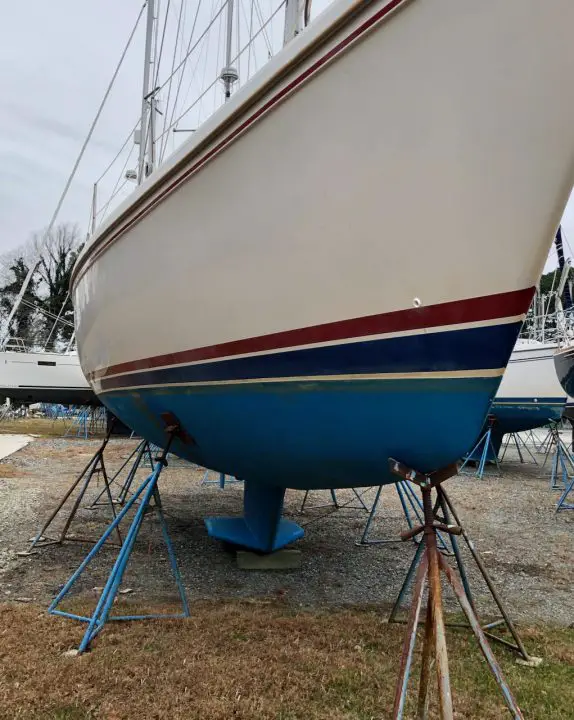
The keel of a sailboat is the underwater profile of the boat that gives it its ability to sail.
A boat sailing downwind is pushed along like a leaf on the surface of the water. But modern sailboats are designed to sail into the wind as well, and to do that, they must embrace some basics of aero- and hydrodynamics.
The sails of a boat sailing upwind work like an airplane’s wings. Their curved shape acts as an airfoil. Air is accelerated over the outer edges, which makes lift thanks to Bernoulli’s Principle.
But there are two problems. Firstly, the boat will heel over as the wind pushes on the sails. Without a significant amount of ballast to counter the force on the sails, the boat will capsize. So the most basic job of the sailboat’s keel is to provide a heavyweight as low in the boat as possible to keep it upright in all conditions.
Of course, the weight could be added without a keel. Early schooners were loaded with stones for ballast. These vessels were very deep but more or less flat-bottomed. They couldn’t sail to windward very well because the entire vessel drifted downwind as the wind pushed on the sails. This drift is known as leeway.
To counter leeway, a keel employs yet another airfoil shape to make lift. This one is underwater, and then the lift it makes is created by the water passing over it as the boat sails along. This lift helps pull the boat to windward and reduces leeway. The more lifting force the keel can make, the better the boat can sail into the wind.
No sailboat can sail directly into the wind. If the boat is close to the wind, it is said to be “in irons.” That means that the air is not flowing smoothly over the sails. The better a boat is at sailing upwind, the closer to the wind it can get. Like those used on racing boats, high aspect ratio fin keels can sail 30 degrees or less to the wind. Most cruising boats must be 45 degrees or more off the wind before they can effectively sail.
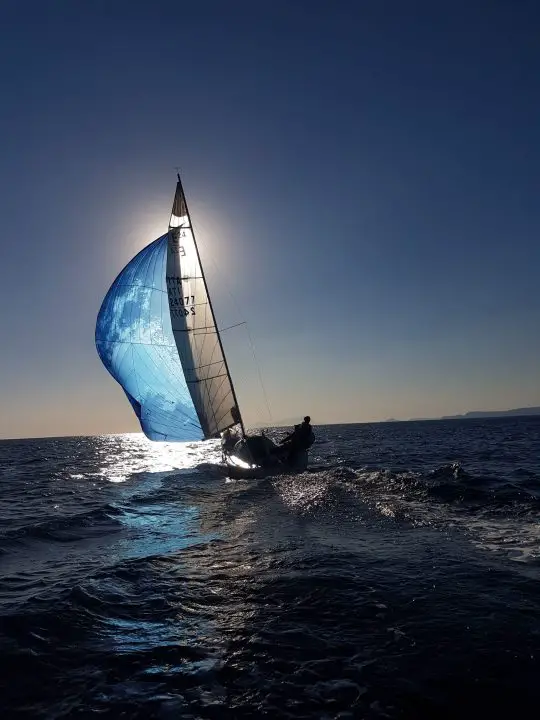
History of Sailboat Keel Design
Traditional offshore sailboats began with full deep keel designs. Shallow draft near-shore workboats often feature flat-bottomed variations that use centerboards, leeboards, or other means to fight leeway and work upwind.
The first progression toward modern keels was the encapsulated deep fin keel. This was a natural progression as designers began working out ways to shrink a full keel down.
Racing boats began tinkering with high aspect ratio fins. Eventually, this technology filtered down to the cruising boat world. These fins were generally cast directly from lead or iron and bolted to the hull. This construction results in some extra maintenance and care that must be taken. A bolted-on keel can be damaged in a grounding in ways that an encapsulated keel cannot. They were and are very robustly built, but they are nonetheless attached with bolts that can be bent.
With the wide adoption of bolt-on keels, designers could better tinker with their designs. Freed from the limits of what could be molded and encapsulated, the keel could take any shape at all.
One disadvantage of the fin keel is its deep draft. A shorter shoal draft keel is one way to fix the problem, but it will require more ballast, and its performance will suffer.
Bulb and wing keel designs came next. These are extra weights attached to the bottom of the keel to increase its effectiveness. Torpedo-shaped bulbs add weight low down, whereas wings provide an opposing lifting force to counter leeway.
Many of the shapes of keels in the winged keel group are descendants of the bulb keel. In many cases, winged keel designs are often built into the cast bulb.
Like many innovations in yachting and sailing, the winged keel was first used as an attempt to gain an advantage during a famous yacht race.
In 1851, the schooner America was sailed to the UK to compete for the 100 Guinea Cup . The ornate and elaborate trophy spent the next 132 years defended successfully by America, to the extent that it became known as the America’s Cup. It is the oldest sporting trophy still contested in the entire world.
With so many wins under their belt, America was sure to lose at least one eventually. And that’s precisely what happened in 1983 when the Australian challengers succeeded with their yacht Australia II.
How did they do it? The same way that yacht designers have been innovating and creating before and since, of course. They look at the rule book and find ways to make a better boat within those rules. At the time, the 12-meter class rules were used for the race. The amount of sail area allowed was an inverse function to the boat’s length and weight.
Designer Ben Lexcen used the rules to his advantage. By figuring out how to make a shorter yet more effective keel design, he could make the yacht lighter while still carrying more sail area. The boat had a great design all around, with effective sails and rig. The combined total effect was that Australia II beat the defenders by an average of one minute on every upwind leg.
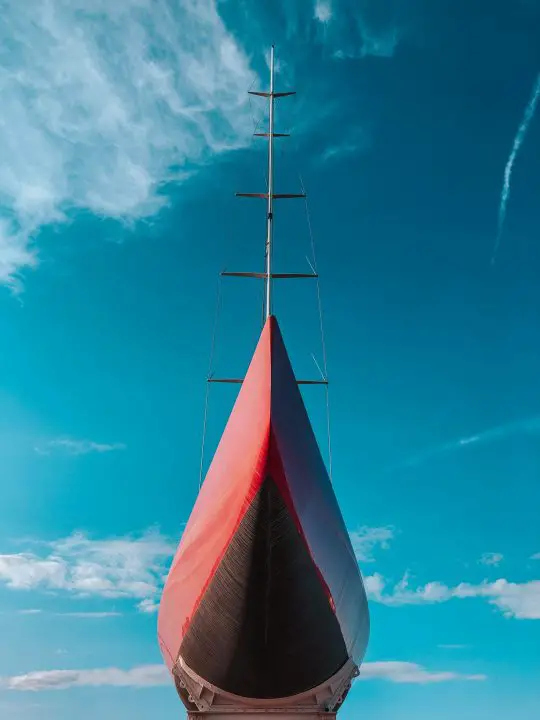
The technology and idea trickled down into even run-of-the-mill sailboats. But those sailboats don’t use their wing keels to win races; they use them to carry shorter keels. A shallow draft is an important consideration for many sailboat owners. Perhaps their home ports have shallow entrances, or perhaps they just like exploring shallow waters. Whatever the reason, the difference between a 4’6″ draft sailboat and a 6’6″ keel is enormous.
It’s not all good news for wings, though. There are some distinct downsides to having one of these hanging off the bottom of your boat. Two operational considerations should be weighed beside the initial cost of casting such a complex shape.
Firstly, what if you run aground? Winged keels are more or less flat on the bottom. Should you accidentally calibrate your depth sounder by grounding on a sandbar or mudflat, wing keels will be more challenging to get off than conventional fins. Not only does heeling the boat over have less effect on freeing you, but the shape of the keel itself can also create a suction in the mud.
Secondly, wing and bulb keels can get tangled in things. The most likely suspect that comes to mind is errant fishing gear, but the more likely problem will stem from your ground tackle. Boats can swing in every direction when wind opposes current, which can often cause a boat to back over its own chain. Doing so while spinning around can cause a line to foul on the wings.
There are many other types of sailboats in the world. Some designers have gotten very creative in their efforts to reduce the draft of a sailboat, and some designs are born from one particular use or another for the boat.
A great example is the bilge keel or twin keel sailboat. These boats are popular in the UK, where enormous tidal ranges make it essential for boats to be able to be safely dried out when the tide goes out. The bilge keeler can sit on its two keels perfectly upright until the tide comes back again and then do it all over again in a few hours. Having this feature on your boat means that, at least in the UK, you’ll have many more choices of places where you can moor your boat, and many of those options will be much cheaper.
Another example of a specialized design with a purpose is the retractable swing keel. What is a swing keel? It’s a heavy, ballasted keel that can retract into the hull. It looks similar to a centerboard keel, only weighted and attached to a larger sailing yacht.
When the boat is offshore and sailing, it has a very effective high aspect ratio airfoil, works great, and has a deep draft. The keel can be retracted entirely in shallow water or if the skipper wants to beach the boat. These boats can explorer areas that most sailboat skippers can only dream of.
The different types of keels are just one fascinating vignette of the beautiful world of yacht design. If you’d like to learn more about what makes these beautiful boats tick, I highly recommend you check out the book Yacht Design According to Perry. Authored by renowned yacht designer Bob Perry , the book talks about all design aspects and provides insight into sailboats.

Prices pulled from the Amazon Product Advertising API on:
Product prices and availability are accurate as of the date/time indicated and are subject to change. Any price and availability information displayed on [relevant Amazon Site(s), as applicable] at the time of purchase will apply to the purchase of this product.
Matt has been boating around Florida for over 25 years in everything from small powerboats to large cruising catamarans. He currently lives aboard a 38-foot Cabo Rico sailboat with his wife Lucy and adventure dog Chelsea. Together, they cruise between winters in The Bahamas and summers in the Chesapeake Bay.
Popular searches
Popular pages.
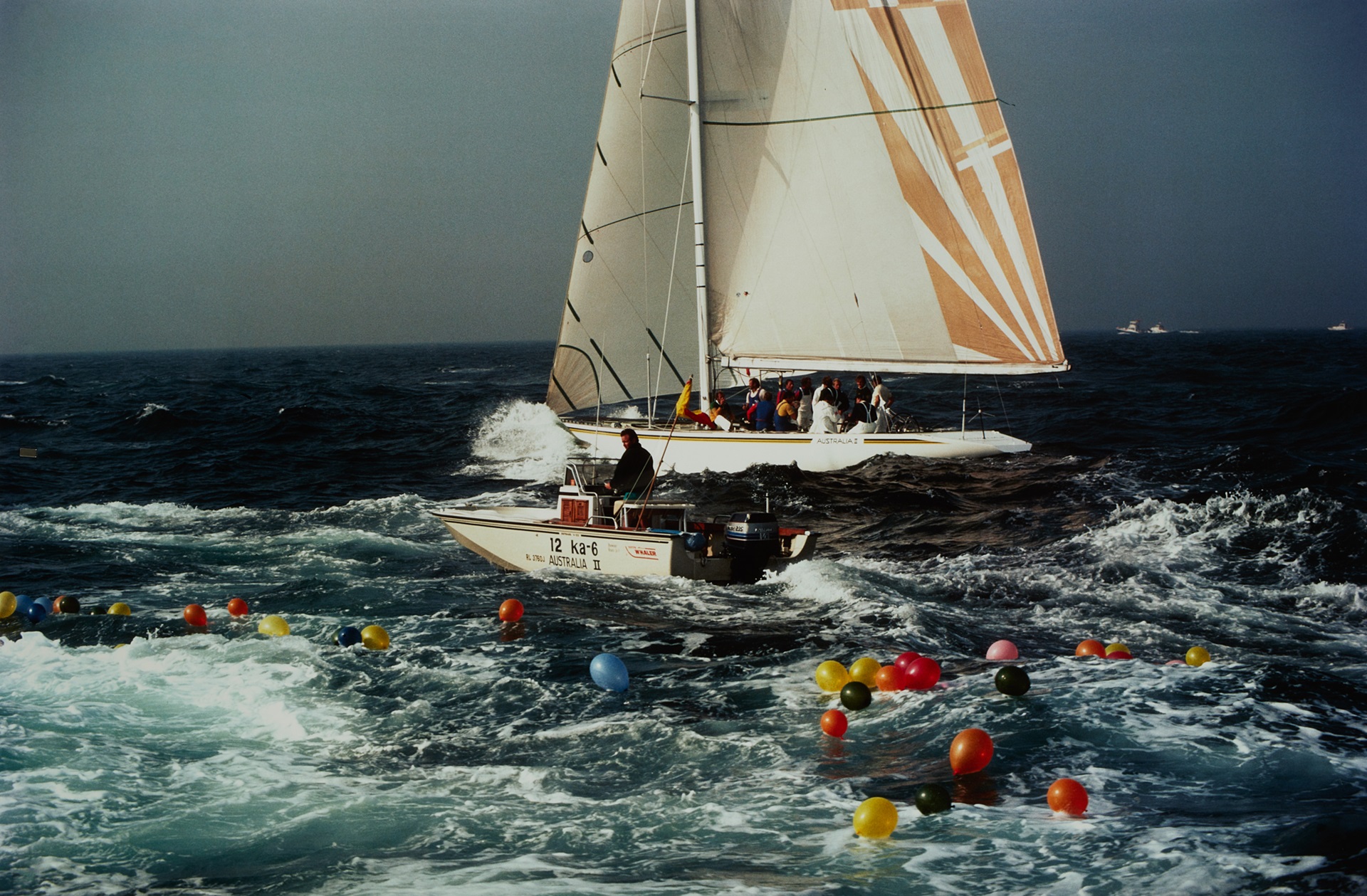
Show us the Keel: Winning the America’s Cup in 1983
Australia II has become one of the nation’s most recognisable vessels, thanks to that extraordinary America’s Cup win in 1983. Almost everyone knows about its upside-down winged keel designed by Australian Ben Lexcen that was unbeatable that year.
In May 1981 Ben Lexcen sent this cryptic telex message from Wageningen (Netherlands) to Perth:
" ABOUT TO TAKE YACHT DESIGN INTO THE SPACE AGE DARTH VADER LOOKS GOOD IN COMPUTER IN 3 DIMENSION WILL TEST ON WEDNESDAY 10th JUNE BEN SKYWALKER" Lexcen had begun testing keel designs with a team at the Netherlands Ship Model Basin. He named his radical concept of an upside-down keel with winglets ‘Darth Vader’, referring to the all-powerful villain of the Star Wars movies that took cinema by storm in 1977 and 1980. Signing his own name after character Luke Skywalker added to the Star Wars connection. Lexcen’s references to Star Wars were part of his quirky character that masked enormous technical ability and non-linear thinking. His drawings chart the progress from a conventional design to the winged profile. His design challenged the strict formula for designing 12-Metre class racing yachts, known as the America’s Cup Rule. A revolution was about to occur. Australia II , with its winged keel was kept literally under wraps before the America’s Cup races off Newport, Rhode Island. To chants of ‘Show us the keel!’ and a media frenzy about what is hidden under the covers, Australia II and its boxing kangaroo mascot sailed to victory and into the hearts and minds of Australians. 26 September 1983 was a monumental day in the history of Australian sport.
Show us the Keel: Winning the America’s Cup in 1983 takes us back to September 1983 when John Bertrand and his crew crossed the line to take the America’s Cup from the USA for the first time in its history. Alongside the design drawings, the exhibition includes a range of items associated with the win. The free exhibition is in Wharf 7, Maritime Heritage Building behind the main museum building and is open from 9am to 5 pm Monday to Friday.
Australian National Maritime Museum, Director, Ms Daryl Karp interviews Australia II skipper, John Bertrand AO on sailing, leadership and the America’s Cup 40 years on.
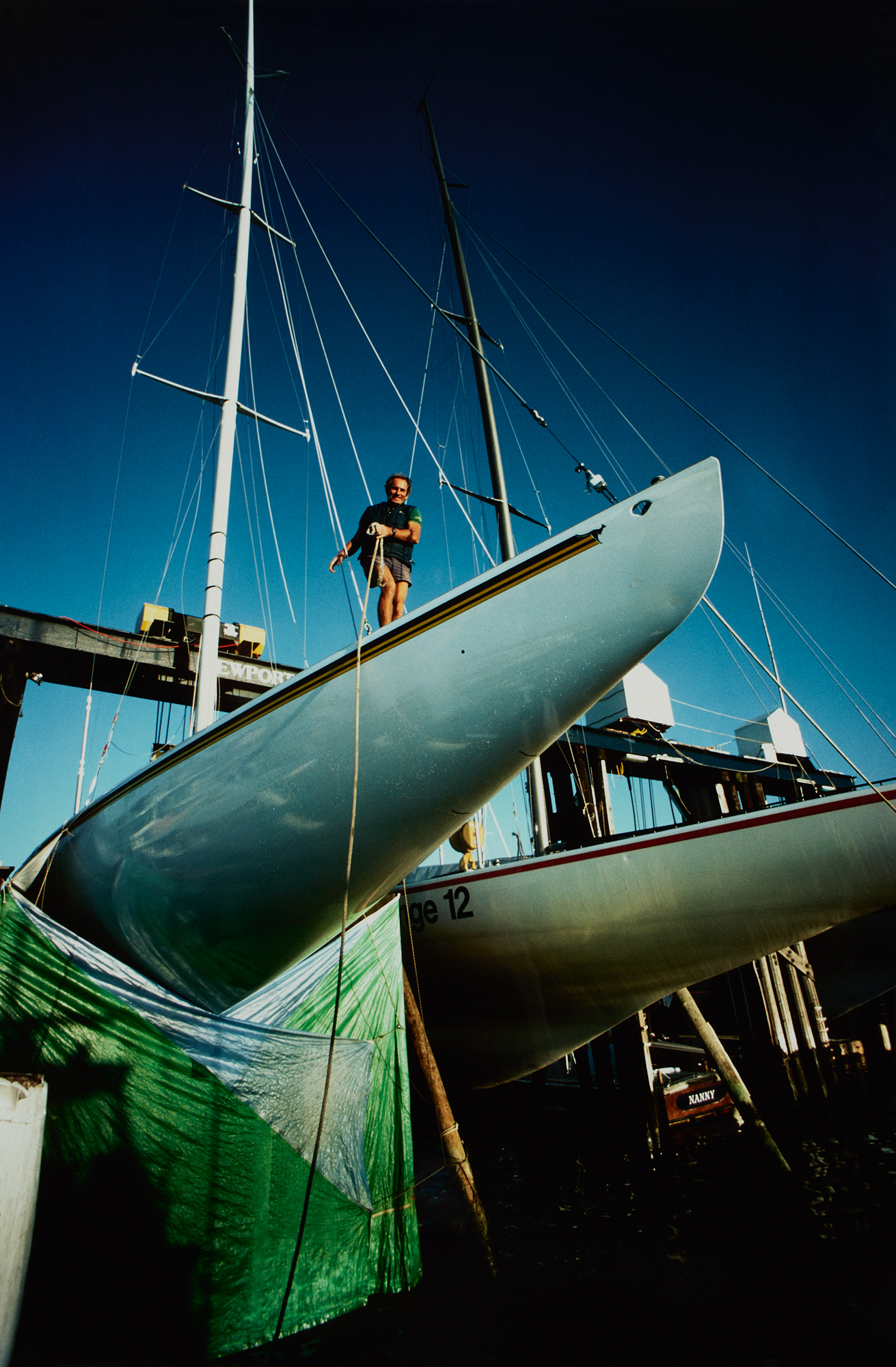
You might like

Wharfies' Mural
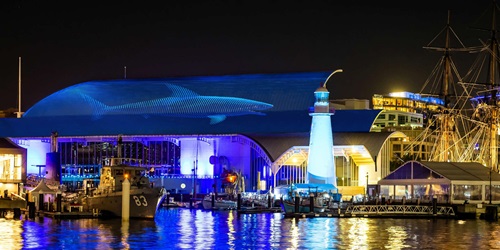

- AMERICA'S CUP
- CLASSIFIEDS
- NEWSLETTERS
- SUBMIT NEWS

Winged Victory - the untold story of Australia II's keel design

Related Articles
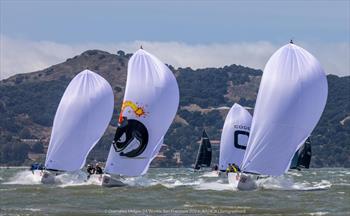

Australia II
- original hull
- original deck
- original layout
- original rigging
- original sails
- Western Australia
- overhanging stem
- overhanging transom
- displacement
- round bottom
- spade rudder
- decked with cockpit
- non-operational
- on public display
- non-floating
- inside building
- awards/trophies
- news clippings
- sport/recreation
- construction/repair
- Discover More

Yachting Monthly
- Digital edition

How keel type affects performance
- Chris Beeson
- December 2, 2016
James Jermain looks at the main keel types, their typical performance and the pros and cons of each

A fin keel and spade rudder configuration gives high pointing but can be sensitive on the helm Credit: Graham Snook/YM

James Jermain has tested hundreds of yachts in his 30 years as Yachting Monthly’s chief boat tester
The performance and handling of a yacht depends on many things, but perhaps the most important single feature is the shape of the hull and the profile of the keel. Over the years hulls have become shallower and keels narrower, but for many types of sailing this progression is not necessarily progress. Of the various shapes that have evolved, each has its own advantages in different circumstances. Here is a run-down of how they may fit your sort of sailing.
FIN KEEL WITH SPADE RUDDER

A low wetted surface area and aerofoil shape means speed and agility
The most common modern option, usually combined with light but beamy hulls with high freeboard.
GENERAL AND TO WINDWARD
- Low wetted surface and good aerofoil shape means good speed, high pointing and quick tacking
- Light steering
- Best designs can slice through heavy seas in reasonable comfort
- High volume, light-weight designs can be lively and tiring in heavy weather
- Flat sections can cause slamming
- Less steady on the helm, requiring more work and concentration
- Strong tendency to round-up when hard pressed
- Generally require earlier reefing
- Can be unstable when hove to
- Quick to surf and may even plane
- Can broach easily and suddenly
- Can be directionally unstable and hard to control in heavy conditions
UNDER POWER
- Handling is precise and turns tight and quick
- Some handle almost as well astern as ahead
- Limited lateral area so susceptible to beam winds at low speeds
- An unattended helm can slam over suddenly
FIN KEEL WITH SKEG RUDDER

The skeg running aft protects the rudder and improves tracking under sail and power
Similar to above but with some key differences.
- Skeg provides better support for the rudder
- Tracking under sail or power is improved
- There is less chance of damage
- More wetted surface so potentially slower
- Objects can get stuck between rudder and skeg
- Limited balancing can make helm heavier

The mass of a long keel is often more seakindly and will carry way well.
The traditional option, usually found on pre-1970s designs.
- Good tracking
- Slow, soft, comfortable motion
- Drive powerfully through short seas but can be wet
- Carry way through tacks
- Resist rounding-up
- Heave-to well
- High wetted surface area and a poor aerofoil shape, so speed reduced, tacking slow, leeway increased and pointing ability reduced
- Long ends can cause hobby-horsing
- An unbalanced hull or rig can cause heavy helm
- Track well and very resistant to broaching
- Very stable in heavy conditions
- Reluctant to surf (a mixed blessing)
- Carry way well
- Track straight
- Heavy construction can reduce vibration and noise
- Large turning circle ahead
- Unpredictable and hard to control astern
LIFTING OR SWING KEEL

A lifting keel enables beaching, but beware of stones jamming the plate
The ultimate shallow-draught option.
- A fully retracting keel offers shallowest draught
- A well-designed lifting keel can be very efficient and fast
- Grounding on anything other than soft mud or sand can damage an unprotected hull
- Stub keels offer better protection but are less efficient and prevent level drying out, except in soft mud
- Stones and dried mud can jam the lifting plate
- Internal keel boxes reduce accommodation space
- Directional stability is poor
- Early surfing and planing
- Control can easily be lost in strong winds
- Good performance and handling with keel down
- Directional control increasingly poor as the keel is raised
TWIN OR BILGE KEEL

A bilge-keeler will dry out upright on a flat bottom
A popular shoal-draught option in Britain, less so abroad.
- Shallower draught
- Dry out upright on a flat bottom
- Good protection when grounding
- Good designs are better to windward than long keels, almost as good as fins
- Pointing and speed to windward is reduced, considerably so in older designs
- When well heeled, waves can slap under the windward keel
- Can topple over if one keel finds a hole or soft ground

Modified water flow over the wing keel foot can give the motion of a longer, heavier boat
Once popular, now largely replaced with various types of bulb.
- Reduced draught
- Low CoG means good righting moment
- Modified water flow over keel foot means greater efficiency and gives the motion of a longer, heavier boat
- More likely to pick up lobster pots, etc
- Risky drying out
- Weed and barnacle growth under wings difficult to remove
Enjoyed reading this?
A subscription to Yachting Monthly magazine costs around 40% less than the cover price .
Print and digital editions are available through Magazines Direct – where you can also find the latest deals .
YM is packed with information to help you get the most from your time on the water.
- Take your seamanship to the next level with tips, advice and skills from our experts
- Impartial in-depth reviews of the latest yachts and equipment
- Cruising guides to help you reach those dream destinations
Follow us on Facebook , Twitter and Instagram.
- View Record

TRID the TRIS and ITRD database
THE DEVELOPMENT OF THE WINGED KEEL FOR TWELVE-METRE YACHTS
This paper presents a numerical and experimental analysis of the winged keel originally developed for the International twelve-metre class yacht Australia II that won the America's Cup in 1983. After briefly explaining why this keel was evolved in 1981, some basic considerations are presented relating keel performance to various design parameters. The results of numerical flow analyses and wind-tunnel measurements on a model of a winged keel are then presented and compared. The differences between the performance with and without winglets fitted to the keel are discussed. The fitting of winglets appreciably enhances the performance of a low-aspect-ratio lifting surface such as the keel of a twelve-metre yacht.
- J. Fluid Mechanics, 173 (1986), p. 55 (Dec.) [17 pp., 12 ref., 15 fig.]
- Oossanen, P
- van Joubert, P N
- Publication Date: 1986
Subject/Index Terms
- Subject Areas: Marine Transportation;
Filing Info
- Accession Number: 00691193
- Record Type: Publication
- Source Agency: British Maritime Technology
- Files: TRIS
- Created Date: Aug 14 1995 12:00AM
- Types of Sailboats
- Parts of a Sailboat
- Cruising Boats
- Small Sailboats
- Design Basics
- Sailboats under 30'
- Sailboats 30'-35
- Sailboats 35'-40'
- Sailboats 40'-45'
- Sailboats 45'-50'
- Sailboats 50'-55'
- Sailboats over 55'
- Masts & Spars
- Knots, Bends & Hitches
- The 12v Energy Equation
- Electronics & Instrumentation
- Build Your Own Boat
- Buying a Used Boat
- Choosing Accessories
- Living on a Boat
- Cruising Offshore
- Sailing in the Caribbean
- Anchoring Skills
- Sailing Authors & Their Writings
- Mary's Journal
- Nautical Terms
- Cruising Sailboats for Sale
- List your Boat for Sale Here!
- Used Sailing Equipment for Sale
- Sell Your Unwanted Gear
- Sailing eBooks: Download them here!
- Your Sailboats
- Your Sailing Stories
- Your Fishing Stories
- Advertising
- What's New?
- Chartering a Sailboat
- Sailboat Keels
Sailboat Keels - For Performance or Convenience?
While it's true that deep-fin sailboat keels are the most efficient of all in terms of windward ability, many anchorages will be opened up to those who opt for a shoal draft alternative, accepting the perceptible loss to windward sailing performance.
Another benefit with shoal draught sailboats is the increased security to be had when lying alongside a wall, or laid-up ashore in a cradle.
Sailboat keels serve two purposes:~
1. to provide ballast low down and
2. to provide lateral resistance to the wind force exerted on the sails
And like all things in the sailboat world, there are trade-offs to be made.
But just what are the alternatives? Let's take a look...
Long (or Full) Sailboat Keels
These sailboat keels are found on the heavy displacement boats of yesteryear, and are still popular with some long-distance cruising sailors. The Nicholson 32 sketched below is a popular example of a long keel sailboat.
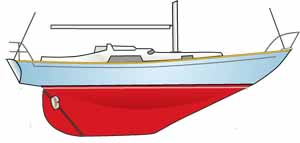
Unlike more modern keels they are built-in as part of the boat's hull construction which, together with encapsulated ballast, makes them extremely robust.
But although well-mannered under sail, such boats are slow and need a large spread of sail to get them moving, especially in light winds. This is largely due to the high wetted area, and consequent drag, of sailboat keels of this type.
In their favour though, long keel sailboats track through the water as if on rails, have a comfortable motion in a seaway and will heave-to readily.
The propeller is protected in an aperture and hulls of this type usually sail over floating fishing gear and pot buoys with impunity.
Close-quarters manoeuvring, such as wriggling in and out of a marina berth, is not their specialty.
Encapsulated Fin Keels
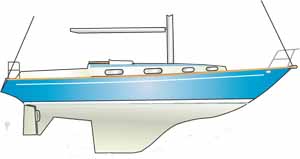
These were the natural development of long fin keels which, whilst retaining their positive attributes, greatly improved manoeuvrability due to the separation of the keel and the rudder.
The Contessa 32 sketched here is a highly regarded example of these long-fin and skeg-hung rudder sailboats.
Deep Fin Keels
Deep fin keels are manufactured separately from the hull, and are subsequently bolted on. Keel bolts have a justified reputation as being 'suspect', owing to their habit of corroding undetected.
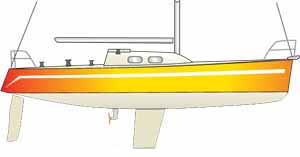
But this type of sailboat keel is more efficient to windward than the previous two keel types, creating more lift and reducing leeway.
All sailboats make some leeway - perhaps just a few degrees - when sailing to windward, which creates an angle of attack between the fin keel and the water flowing past it.
Much like a sail, or indeed an aircraft's wing, this produces an area of low-pressure flow on one side of the foil and high pressure on the other. The keel tends to move into the low-pressure area, conveniently reducing leeway and dragging the boat up to windward.
Retractable Keels
Retractable keel sailboats, or lifting keel sailboats, types rely on ropes and pulleys - or hydraulic rams in some cases - to retract a steel centreplate into a keel housing. Some types operate vertically and others pivot around a pin at the forward end, like that on the swing-keeler shown here.
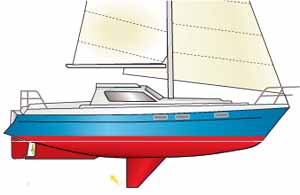
In some designs a ballast stub keel is retained which contains the keel housing. Others have no stub keel at all and all of the keel housing projects into the boat to some degree, usually to the detriment of the accommodation.
When all goes well, sailboat keels of this type would seem the ideal solution to provide deep draft offshore and shoal draft when navigating in shallow waters.
Another much heralded benefit is the ability to dry out upright, particularly when partnered with a twin rudder design. Nevertheless, some offshore sailors may feel that that the added complexity and possibility of failure outweighs all other advantages.
Most skippers of lifting keel boats that I've spoken to have experienced, or continue to worry about, at least one of the following:
- That keel slot in the bottom of the boat. How well engineered is it to resist the side loads imposed on it by the centreplate?
- The rope and pulleys that operate the centreplate. When is something going to break?
- When are all the barnacles, firmly attached to the 'impossible to anti-foul' inner surfaces of the keel housing, going to gang-up and jam the centreplate?
- How soon before a stone wedges itself between the centreplate and the keel housing, firmly jamming it in the 'up' position?
- How much longer can I put up with the noise of the thing rattling around?
But they have their moments of glory...
For UK yachtsman tempted by the prospect of warm water Mediterranean sailing, but not overly enthused about the exposed passage around the Iberian Peninsular and through the Straits of Gibraltar, a retractable keel sailboat will get him there through the Canal de Garonne and the Canal du Midi.
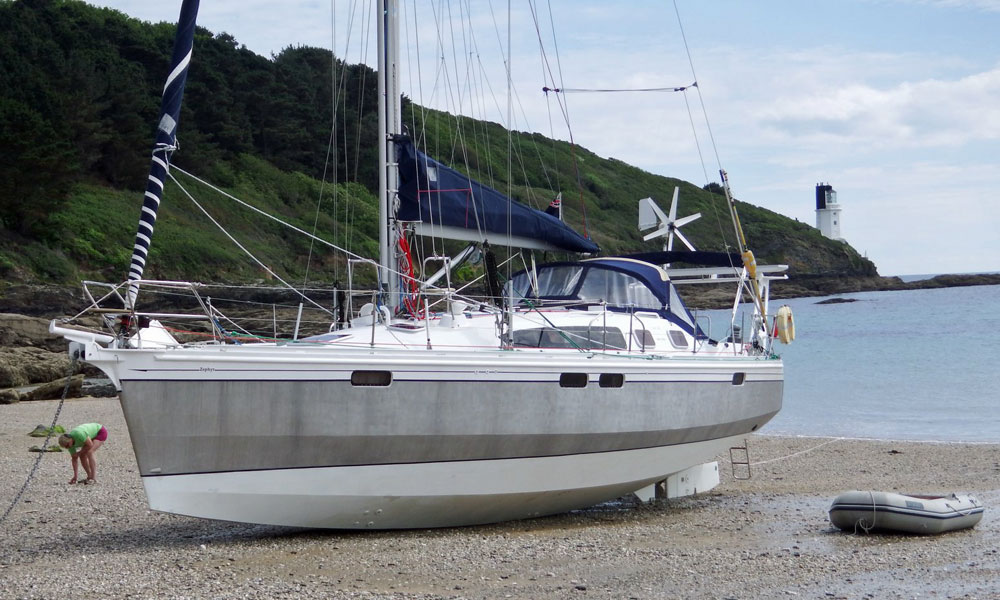
Twin, or bilge keels
These are a peculiarly British thing. Nowhere else do they seem to enjoy the same level of popularity.
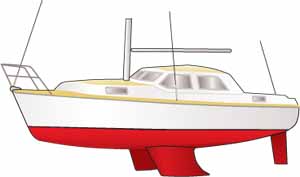
Along with long-legged birds and wellie-clad bait diggers, bilge keelers are very much at home on tidal mud flats, where drying moorings are much less expensive than the deep water kind.
Apart from their shallow draft, the benefit of a bilge keeler is that these cheap moorings can be enjoyed without falling over - twice a day in fact.
And that's it, as far as I can see. Underway, their high wetted area and lack of low-down ballast can only detract from their sailing performance - and if you inadvertently run aground in one of these, you may be there for a while, since you can't heel the boat to reduce its draft.
But they're very popular here in the UK, so I mustn't be too rude about them.
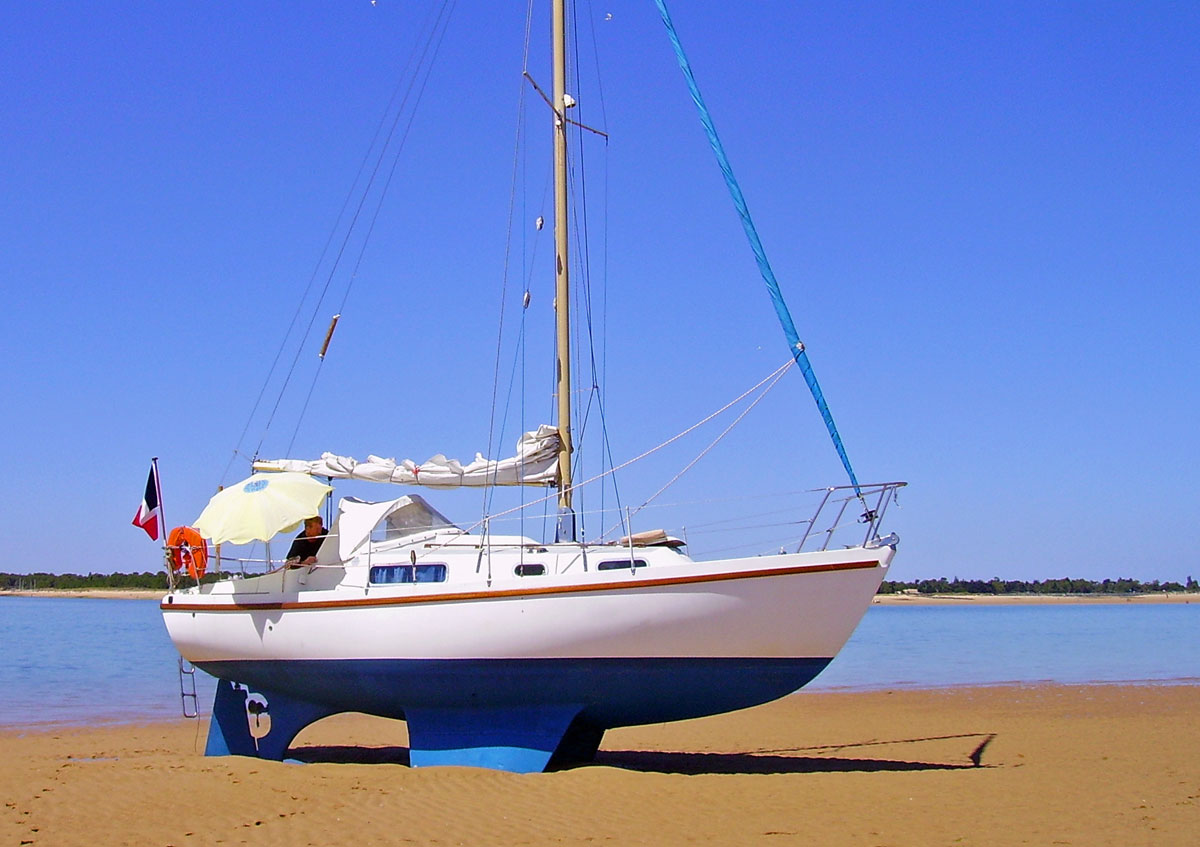
Sailboat Keels with Bulbs or Wings
One way to reduce draft whilst minimising the affect on stability is to provide additional ballast in the form of a lead bulb on the bottom of the keel.
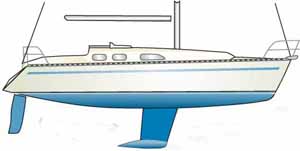
Variations on these types of sailboat keels include torpedoes, the Scheel keel and the wing keel.
Properly designed 'torpedoes' meet this requirement, and providing they don't project forward of the keel's leading edge - where they'll collect pick-up lines, discarded fishing nets and other assorted flotsam and jetsam - are a good solution for offshore yachts.
The Scheel keel , invented by the American designer Henry A Scheel, is said to create additional lift through the converse sections on top of the bulb, and appears on several highly-regarded offshore designs.
Wing keels develop this principle further, but share the same propensity for collecting unwanted hangers-on as the forward projecting torpedo.
Wings increase wetted area, and hence drag, but as well as producing more hydrodynamic lift they do provide a degree of 'damping' in a rolly anchorage.
You'll need to support the boat in slings to anti-foul the underside of the wing, or alternatively employ a diver to scrub it clean at regular intervals.
Tandem Keels
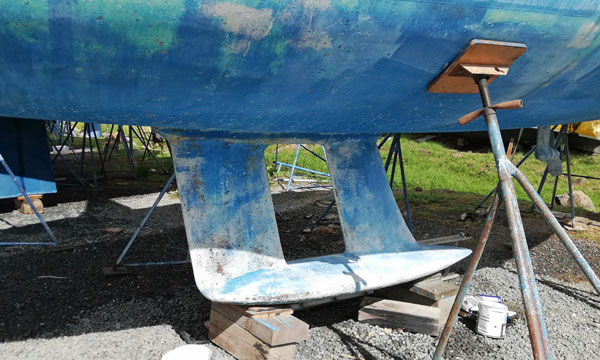
This is a tandem keel, designed by Warwick Collins back in the 1980's. Essentially a tandem keel comprises two foils and a delta endplate to create a shoal draft keel which is genuinely as effective upwind as a deep keel.
These keels had some success on the racing circuit and were also found on cruising yachts, including Bavarias and Etaps.
At first glance it would seem that the water flow around the forward foil would disrupt the flow around the after one, but this is not the case. Owing to the boat's leeway, both keels operate in laminar flow.
Benefits of the tandem keel include:
- With 55%-60% of its weight in the endplate, stability is very good.
- The end plate dampens the boat's motion at sea, increasing crew comfort.
- The additional stability allows the rig to work more efficiently creating more drive and better boat speed.
- The tandem keels' lower aspect ratio (shallow and long) improves directional stability.
So what's not to like? Very little it would seem, although going aground with this (or any wing keel design) is likely to be embarrassing. And of course, they're expensive in comparison to less radical designs.
You might like to take a look at these...
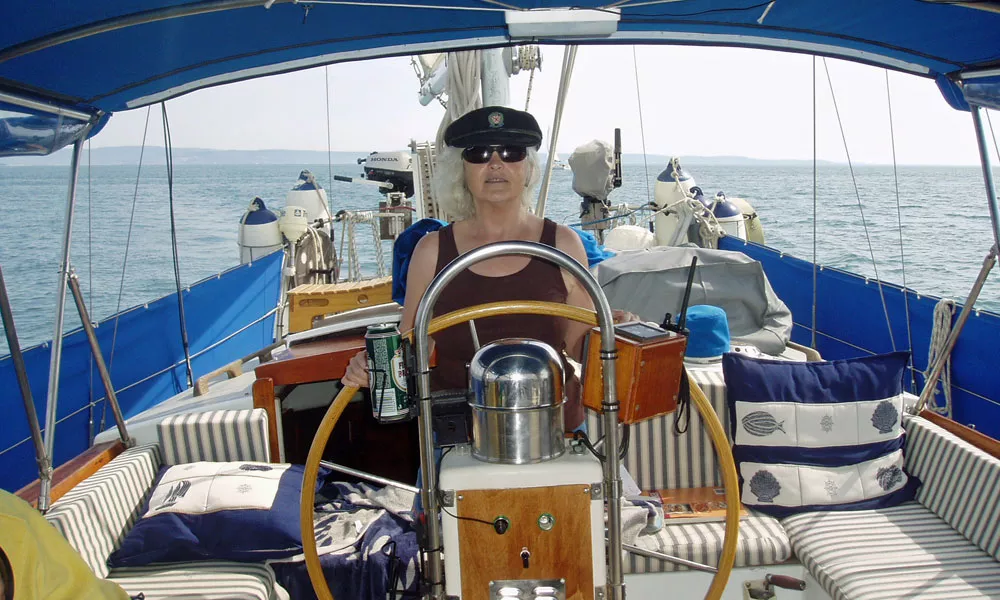
The Case for Sailboat Tillers as an Alternative To Wheel Steering
Just why do so many modern sailboats have wheel steering when sailboat tillers are cheaper, more reliable and convenient? Check out this comparison between wheels and tillers
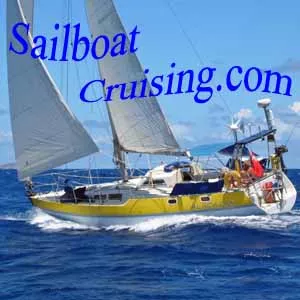
Understanding Hullspeed and the Speed/Length Ratio
For any displacement hull of a given length there's a maximum hullspeed; the longer the waterline length, the quicker the boat. Here's how it works
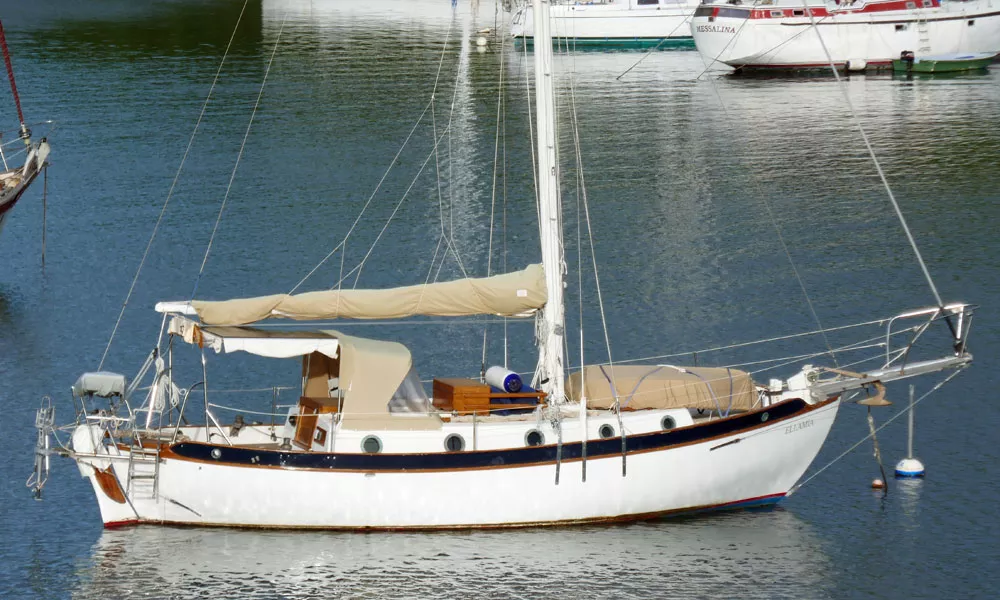
Are Heavy Displacement Hulls the Best Choice for Offshore Cruising?
Increasingly, offshore sailboat skippers are choosing moderate displacement hull forms in preference to heavier vessels when planning for an ocean crossing. And here's why...
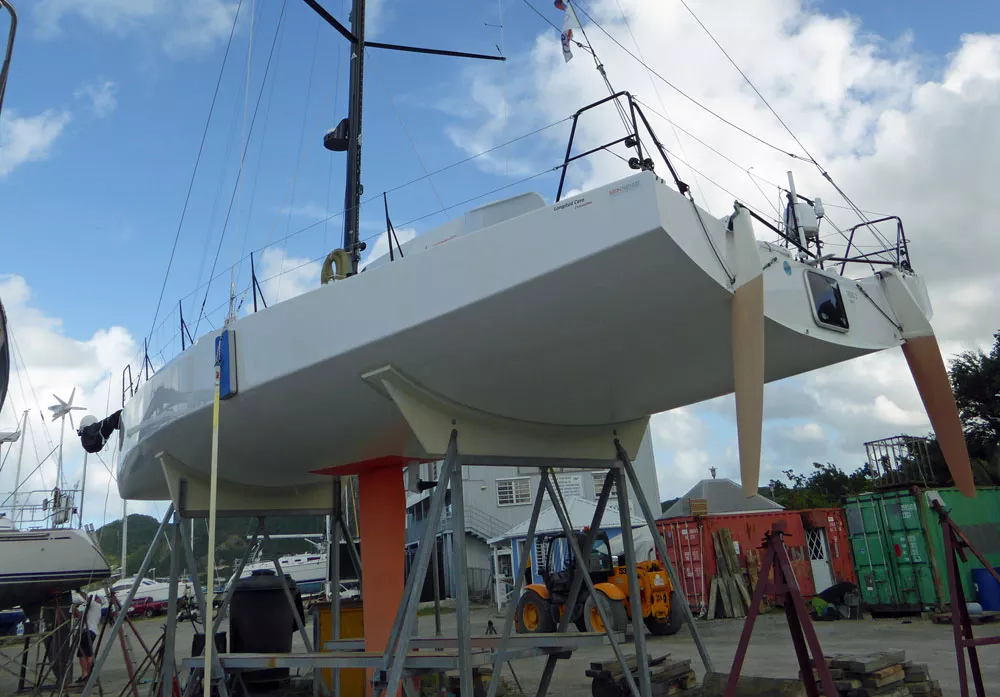
Sailboat Rudders
Illustrated examples of Balanced Sailboat Rudders, Semi-Balanced Rudders, Keel-Hung Rudders, Skeg-Hung Rudders, Spade Rudders, Twin Rudders, and Transom-Hung Rudders
A Sailboat Cockpit Must be Workable, Comfortable and Safe
The sailboat cockpit has to operate as an efficient work station when underway, and a comfortable leisure area when at anchor, but on some sailboats the compromise is not always successful
Recent Articles
Jeanneau Sun Odyssey 409 Specs
Aug 22, 24 11:02 AM
Slocum 43 Specs & Other Info
Aug 22, 24 02:31 AM
Sovereign 51 Specs & Data
Aug 21, 24 05:54 AM
Here's where to:
- Find Used Sailboats for Sale...
- Find Used Sailing Gear for Sale...
- List your Sailboat for Sale...
- List your Used Sailing Gear...
Our eBooks...

A few of our Most Popular Pages...

Copyright © 2024 Dick McClary Sailboat-Cruising.com
Practical Boat Owner
- Digital edition

Keel types and how they affect performance
- Peter Poland
- June 19, 2023
Peter Poland looks at the history of keel design and how the different types affect performance

The Twister is a well-proven example of a generation of production yachts with ‘cutaway’ full keels and keel-hung rudders. Credit: Graham Snook/Yachting Monthly
Having been a boatbuilder for around 30 years until the very early ‘noughties’, I’ve already witnessed – and even taken part in – a lot of changes in the world of yacht design and building.
Yacht design originally evolved as traditional workboats developed into leisure craft.
In his History of Yachting , Douglas Phillips-Birt writes that the Dutch, who gave the name ‘yacht’ to the world, were probably the first to use commercial craft for pleasure in the 16th century.
They created the first yacht harbour in Amsterdam in the 17th century.
When the schooner America visited the UK in 1851 and raced around the Isle of Wight, this led to the America’s Cup and the resulting merry-go-round of race-yacht design that continues to this day.

The Jeanneau Sun Odyssey 35 offers three different fin keel configurations with different draughts plus a lifting keel version with a centreplate housed in a shallow winged keel stub. Credit: David Harding
The creation of what is now the Royal Yachting Association ( RYA ) in 1875 led to the introduction of handicap rules, establishing the sport in Britain.
These rating rules – and their numerous successors down the ages – have helped determine the evolution of yacht design and keel shapes.
Many early yachts were closely based on workboats, commercial cargo carriers or even privateers and naval vessels.
Initially, the ballast was carried in a long keel and the bilges .
New racing rules of the day taught designers to seek and tweak performance-enhancing features.
Maybe racing did not always improve the breed, but it certainly kept it moving ahead.

Artwork inspired by Ted Brewer’s illustration of keel types (excluding centreplate or lifting keels)
The late, great designer David Thomas believed that fishing boats, pilot cutters and oyster smacks had a large influence on the sport of sailing.
Each type of workboat was built to fulfil a specific purpose. And many had to be sailed short-handed while carrying heavy cargoes.
So they needed to combine form and function, sail well and be able to cope with heavy weather.
Proof of the versatility of working boat designs was provided by Peter Pye and his wife, Anne.
They bought a 30ft Polperro gaff-rigged fishing boat (built by Ferris of Looe in 1896) for £25 in the 1930s.
Having converted her to a sea-going cutter, and renamed her Moonraker of Fowey , they sailed the world for 20 years.
It proves how the simplest working boat design can cross oceans and fulfil dreams.
Racing influence on keel types and design
Most early yacht designs were schooners, but during the latter half of the 19th century the gaff cutter rig started to dominate the scene.
Many notable yachts were built at that time and the most important racing design was probably the yawl Jullanar (1875).
Designed and built by the agricultural engineer EH Bentall, she had, in his own words, “the longest waterline, the smallest frictional surface, and the shortest keel”.
She proved to be extremely fast and in her first season won every race she entered. Jullanar became the forerunner of such famous designs as GL Watson’s Thistle (1887), Britannia (1893), and Valkyrie II and Valkyrie III , both of which challenged for the America’s Cup during the 1890s.

Compare the She 36’s graceful overhangs with the vertical stems and sterns of most modern cruiser/racers
In the USA, Nat Herreshoff experimented with hull forms for racing yachts and produced the ground-breaking Gloriana in 1890.
She was a small boat for the times, with a waterline length of 46ft. Her hull form was very different to anything yet seen in the USA.
With long overhangs at bow and stern, her forefoot was so cut away that the entry at the bow produced a near-straight line from the stem to the keel.
It was a revolutionary design, and nothing at the time could touch her on the racecourse.

Many French models, such as this Beneteau, have opted for substantial pivoting keels. Credit: Peter Poland
Herreshoff wrote: “Above the waterline everything on Gloriana was pared down in size and weight… and every ounce of this saving in weight was put into the outside lead.”
Early English rating rules produced the ‘plank-on-edge’ yacht, where the beam became narrower and the draught got deeper.
New rating rules were then adopted to discourage this extreme type and eventually the Universal Rule was introduced in the USA and the International Rule – which produced the International Metre Classes – took over in Europe.
Yet again, racing rules proved to be a major influence on design development.
By the start of the 20th century the big, long-keeled racing yachts like the J Class attracted a lot of public attention, but after World War II everything changed. Yachts built to the Universal Rule fell from favour.
The age of the racing dinghy arrived and the ocean racer became the performance yacht of the future.
To new extremes
A 300-mile race from New York to Marblehead saw the start of offshore racing and the first Bermuda race was run in 1906.
The British were slower to compete offshore, but in 1925 seven yachts took up the challenge to race round the Fastnet Rock, starting from the Isle of Wight and finishing at Plymouth.
EG Martin’s French gaff-rigged pilot cutter Jolie Brise won the race and the Ocean Racing Club was formed.
In 1931 this became the Royal Ocean Racing Club (RORC), which remains the governing body of offshore racing in Britain.

The ‘cutaway’ modified full keel was famously used by Olin Stevens on his mighty Dorade. Credit: Christopher Ison/Alamy
The early competitors in RORC races were long-keeled cruising boats, many of them gaff rigged and designed for comfort and speed.
But everything changed in 1931 when the young American Olin Stephens designed and then sailed his family’s 52ft yawl Dorade across the Atlantic to compete in that year’s Fastnet race.
She won with ease. Then she did it again in 1933, having first won the Transatlantic ‘feeder’ race.
At 52ft LOA, with sharp ends and 10ft 3in beam, some said Dorade looked like an overgrown yawl rigged 6-metre. But her triple-spreader main mast was revolutionary. As were her cutaway forefoot, lightweight construction, deep ballast and 7ft 7in draught.
Dorade took the long keel format to new extremes.
In the USA, the Cruising Club of America (CCA), founded in 1922, played much the same role as the RORC did in Britain.
It introduced its own rating rule which influenced the evolution of yacht design in the USA.

The Elan 333. Both the deep (1.9m) and shallow (1.5m) draught models feature an elegantly faired bulb keel and spade rudder. Credit: Peter Poland
Beam was treated more leniently under the CCA rule, so wider American designs later offered more space for accommodation and a bit more inherent form stability than RORC-rule inspired yachts.
Many famous designers of long-keel racing yachts at this time developed their skills at the yachtbuilding firms they ran, such as William Fife II (1821–1902), his son William III (1857–1944), Charles E Nicholson (1868–1954) of Camper & Nicholsons and Nat Herreshoff of Bristol, Rhode Island.
Around the same time several British yacht designers made their names, including George L Watson (1851–1904) who set up one of the earliest Design Offices and Alfred Mylne (1872–1951), who designed several successful International Metre Class yachts.
Norwegian designers Colin Archer (1832–1921) and Johan Anker (1871–1940) also joined the party.
Continues below…

Boat hull design: how it impacts performance
Peter Poland explains how boat hull design has evolved over the years and how it affects boat handling and accommodation

Sail boat rigs: the pros and cons of each popular design
Peter Poland looks at the history of popular rig designs and how the different types affect boat performance

Improve performance by understanding boat design
Øyvind Bordal explains how form stability, LOA, LWL, speed tables and polar diagrams can help you choose the right boat…

Coming of age: the 1970s yacht designs that have stood the test of time
Sailing in the 1970s was characterised by innovation, enthusiasm, mass participation and home boatbuilding. Rupert Holmes reports
In 1873 Archer designed the first long keel Norwegian yacht, but his real interest was work boats – pilot boats, fishing craft, and sailing lifeboats – some of which were later converted into cruising yachts.
Erling Tambs’s Teddy was a classic Colin Archer long keel canoe-stern design in which he wandered the globe with his young wife and family.
He proved the seaworthiness of Archer’s yachts, as well as their speed, by winning the 1932 Trans-Tasman yacht race.
Fellow Norwegian Johan Anker – a one-time pupil of Nat Herreshoff – became equally famous, thanks to his Dragon-class design that still races today.
As a new generation of designers arrived on the scene in the 1930s, hull tank testing became more sophisticated.
Long keel designs became as much a science as an art.
The leader of this new wave of designers, Olin J Stephens, had been a junior assistant to Starling Burgess who designed race-winning J Class yachts, including the iconic Ranger .
Tank testing was then in its infancy but the USA was ahead of the game and Stephens stored away everything that he learned. He enjoyed a head start over his contemporaries.
Keel types: Fin keels
Between the 1930s and the 1980s more fin keel designs began to arrive on the scene and his firm Sparkman & Stephens produced many of the world’s top ocean racers.
He also designed America’s Cup 12-Metres that defended the cup up to 1983 until Ben Lexcen’s winged keel shook the sailing world.
Many S&S fin keel and skeg production boats – such as the Swan 36 (1967), 37, 40, 43, 48, 53 and 65, She 31 (1969) and 36 and S&S 34 (1968) – still win yacht races and are much sought after as classics.
The S&S 34 has several circumnavigations to its name. Stephens, of course, had his rivals.
Among these was the Englishman Jack Laurent Giles, whose light displacement race-winner Myth of Malham had one of the shortest ‘long keels’ of all time.
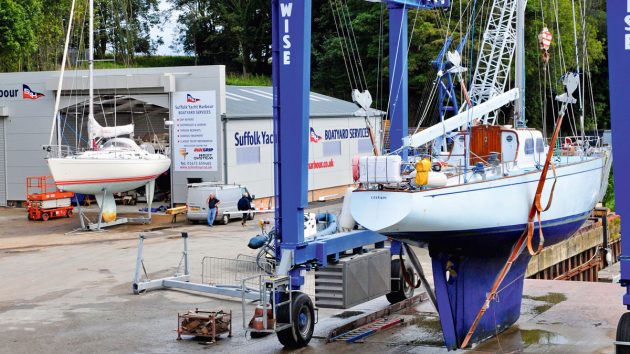
(L-R) A Sigma 38 designed by David Thomas and Gulvain (1949) by Jack Giles as a development of his Fastnet-winning Myth of Malham have very different keel types. Credit: Peter Poland
The Dutchman EG Van de Stadt designed the Pioneer 9 (1959) which was one of the first GRP fin keel and spade rudder racers.
Towards the end of his career, Olin Stephens also came up against Dick Carter, Doug Peterson, German Frers and the Kiwis Ron Holland and Bruce Farr.
The development of new shaped keels went hand in hand with this rapid evolution in yacht design.
The full keel, as still found on motor-sailers such as the Fisher range, gave way to the ‘cutaway’ modified full keel as famously used by Olin Stephens on his mighty Dorade , designed back in the late 1920s.
She still wins ‘classic’ yacht races in the USA. American designer Ted Brewer wrote in ‘ GoodOldBoat ’ that Dorade’s offshore racing successes proved that the full keel is not essential for seaworthiness.

The Nicholson 32’s modified ‘cutaway’ long keel results in excellent performance and handling. Credit: Genevieve Leaper
As a result of its improved performance and handling, the modified ‘cutaway’ long keel caught on quickly and became the standard for around 35 years.
This keel type is found on numerous popular designs such as the Nicholson 32 , 26 and 36, Twister 28 and many Nordic Folkboat derivations.
The modified full keel format had a cutaway profile, giving good handling and directional stability while having less wetted surface than the full keel designs.
These yachts can perform well in all conditions and have a comfortable motion.
Even though they are generally of heavier displacement than fin keelers, they are not much slower in light airs , despite their added wetted surface area.
Their main drawback is a wide turning circle ahead and reluctance to steer astern when under motor.
Keel types: Increased stability
The modified full keel was subsequently cut away more and more for bluewater and inshore racers in an attempt to reduce wetted area until, finally, some designers took it to extremes.
As a result, much-reduced directional stability produced craft that were difficult to steer in breezy conditions, broaching regularly.
Whereupon the fin keel and skeg-hung rudder took over, reinstating increased directional stability, improving windward ability, reducing drag and restoring – when under power – control astern and on slow turns.
This fin and skeg format was later followed by the NACA sectioned fin keel with a separate spade rudder .
Soon, many performance cruisers followed this race-boat trend.
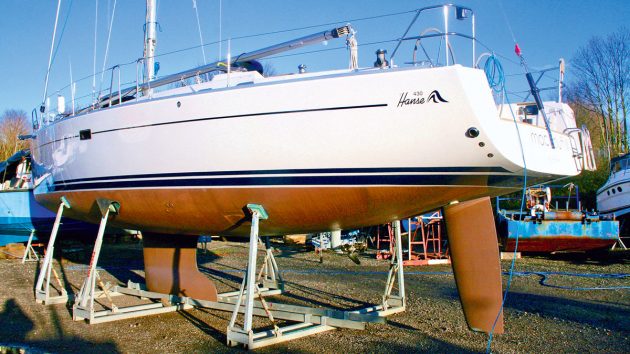
The Hanse 430 has a spade rudder and bulbed keel (draught 2.16m or 1.79m shoal draught. Credit: Peter Poland
Many builders now also offer shoal draught fin keel options and shallower twin rudders.
Some, such as Hanse, incorporate L- or even T-shaped bulbs on some Hanses and Dehlers at the base of finely shaped cast iron fins.
A new international competition had encouraged the initial development of modern fin keel yacht designs.
The revamped One Ton Cup was launched in 1965 for yachts on fixed handicap ratings (typically around 37ft long).
This spawned later fixed-rating championships for Quarter Tonners (around 24ft), Half Tonners (around 30 ft), Three-Quarter Tonners (around 33ft), and finally Mini-Tonners (around 21ft).
All these yachts were eventually handicapped under the International Offshore Rule (IOR) that replaced the old RORC and CCA rules.

The revamped One Ton Cup helped encourage the developed of modern fin keel designs. Credit: Getty
Countless production fin keel cruisers designed and built in the 1970’s to 1990’s boom years were loosely based on successful IOR racers that shone in the ‘Ton Cup’ classes.
The IOR handicap system’s major drawback was its Centre of Gravity Factor (CGF) that discouraged stiff yachts.
Once the international IRC rule replaced the IOR, more thought was given to increasing stability by putting extra weight in a bulb at the base of the keel.
GRP production boats followed suit. The keel foil’s chord needed to be wide enough to give good lateral resistance (to stop leeway), yet not be so wide as to add unnecessary drag.
Exaggeratedly thin foils are not suited to cruising yachts because they can be tricky upwind.
Tracking is not their forte and they can stall out. A bonus was an easier ride downwind thanks to wider sterns.
Keel Types: Lead or iron?
And then there is lead. Almost every production cruiser has a cast iron keel for one simple reason; it is much cheaper than lead. But it’s not as good.
Not only does it rust; it is ‘bigger’ for the same given weight. A cubic metre of iron weighs around 7,000kg, while the same cubic metre of lead weighs around 11,300kg.
An iron keel displaces far more water (so has more drag) than the same lead weight. We had always put iron keels under our Hunters – as did our competitors.
But when we came to build the Van de Stadt HB31 cruiser-racer, designer Cees van Tongeren said “No. We use lead.” “Why?” I asked. Cees replied: “If we use iron, the keel displaces more, so the boat sails worse.”

Rustler 36 long keel’s cutaway forefoot delivers responsiveness and manoeuvrability – a reason the design is so popular in the Golden Globe Race. Credit: Beniot Stichelbaut/GGR/PPL
Which explains why top-flight race boats have lead keels – or at the very least composite keels with a lead bulb or base bolted to an iron upper foil, thus lowering the centre of gravity (CG).
Some modern production cruiser-racers offer high-performance lead or lead/iron composite keels – but at a price.
Many Danish X-Yacht and Elan race-boat models, for example, have a lead bulb on the base of an iron NACA section fin.
Rob Humphreys, current designer of the popular Elan and Oyster ranges, said: “The T-keel is good if you have sufficient draught available. If not, the fin element has too short a span to do its job. This is because the T-bulb doesn’t contribute as usefully to side force as a ‘filleted L-bulb.’
“I developed and tested this shape (a blended-in projection off the back of the main fin) for the maxi race boat Rothmans in 1988/9, and have since used it on the Oysters and Elan Impressions. The ‘filleted’ keel we tested for Rothmans had slightly more drag dead downwind (more wetted area) but was significantly better when any side-force occurred; and side-force goes hand-in-hand with heel angle – which is most of the time! When the model spec allows for reasonable draught, the keel option with the lowest centre of gravity will invariably be a T-keel, with a longer bulb giving the greatest scope for a slender ballast package. An L-keel is a compromise and doesn’t suffer from the risk of snagging lines, mooring warps, and nets. [many modern production cruisers have 100% cast iron L- or T-shaped keels]. A lead bulb is preferable to a cast iron keel in terms of volume and density, but it costs more. However, a lead T-keel in a production environment will almost certainly use a cast iron or SG Iron fin, which may rust.”

The Mystery 35, designed by Stephen Jones and built by Cornish Crabbers, has a lead fin keel. Photo: Michael Austen/Alamy
Rustler Yachts also uses lead instead of iron for their keels.
The Rustler 36 long keel (designed by Holman and Pye and winner of the 2018 Golden Globe Race) has a cutaway forefoot to improve responsiveness and manoeuvrability.
The long keel creates more drag but, as with the Rustler 24, the cutaway forefoot makes the 36 more nimble than a full long keel boat, which are more difficult to manoeuvre in reverse under power.
The rest of Rustler’s offshore range – the Rustler 37, 42, 44 and 57 – designed by Stephen Jones – have lead fin keels.
As does his Mystery 35 built by Cornish Crabbers.
These offer an excellent combination of directional stability, performance and lateral stability. The yachts track well, are comfortable in choppy seas, and have good manoeuvrability, all without the flightiness of shorter chord fin keels found on many production family cruisers.
A digital future
Influential designer David Thomas said: “When I started designing, I integrated sharp leading edges to the keel; until someone told me a radius was better. Then we were all taught that an elliptical shape was better still. With the advent of computers, designers could better visualise the end-product; and clever ‘faring programs’ speeded this up.”
So where next? A combination of lighter and stronger materials, rapidly developing computer programs, a desire for maximum interior volume and low costs has led us to today’s production yacht.
Twin rudders improve the handling of broad-sterned yachts when heeled.
The IRC rating rule permits low CG keels, wider beam and near-vertical bows and sterns.
And designers now have an array of new computer tools at their disposal. But maybe there’s still that element of black magic?
As David Thomas so succinctly said: “You can design a yacht 95% right, but the last 5% can be down to luck.”
Keel types : the pros and cons
Full length keel

The Fisher 31 and many motor-sailers have long keels. Credit: Peter Poland
Pros: Directional stability. Heavy displacement leading to comfort at sea.
Cons: Poor windward performance. Large wetted surface leads to drag. When under power at low speeds, the turning circle is wide unless fitted with thrusters. The same applies to manoeuvring astern.
Cutaway modified long keel form with keel-hung rudder
Pros: Reduced wetted surface area leading to increased boat speed. Better windward performance and handling than full length keel. Rudder on the aft end of the keel improves self-steering ability on some designs.
Cons: Under engine, this keel form has a large turning circle ahead and poor control astern. Since the rudder is not ‘balanced’, the helm on some designs can feel quite heavy.
Fin keel with skeg-hung rudder

The skeg gives protection to the rudder. Credit: Graham Snook/Yachting Monthly
Pros: The further reduction in wetted surface area leads to more boat speed. Directional stability and close-windedness are also improved. If full depth, the skeg can protect the rudder against collision damage.
Cons: When combined with a narrow stern, this keel format can induce rolling when sailing dead downwind in heavy winds.
Fin keel with separate spade rudder

Fin keel with spade: Low wetted surface and aerofoil shapes enhance performance. Credit: Graham Snook/Yachting Monthly
Pros: The fin and spade rudder mix reduces wetted surface and gives a more sensitive helm – especially if the blade has ‘balance’ incorporated in its leading edge. Handling under power in astern is precise and the turning circle is small.
Cons: The rudder is fully exposed to collisions. There are no fittings connecting the rudder to a keel or skeg, so the rudder stock and bearings need to be very robust.
Shallow stub keel with internal centreplate.
Pros: When lowered, the plate gives good windward performance. The plate can act as an echo sounder in protected shallow water. There is normally no internal centreplate box to disrupt accommodation. With the plate raised, off-wind performance is good.
Cons: The plate lifting wire needs regular inspection and occasional replacement. Windward performance with the plate raised is poor.
Lifting or swing keel

Boats with lifting keels tend to surf earlier downwind. Credit: Graham Snook/Yachting Monthly
Pros: Shallowest draught so more cruising options; can also be moored on cheaper moorings. Surfs early downwind. Small wetted surface so can be fast.
Cons: Reduced living space due to internal keel box. With a raised keel, poor directional control. Susceptible to hull damage if grounding on hard material.
Twin or bilge keel

Bilge- or twin-keelers can take the ground on the level. Credit: Graham Snook/Yachting Monthly
Pros: Can take the ground in a level position. Modern twin-keel designs with around 15º splay, around 2º toe-in and bulbed bases perform well upwind. Good directional stability due to the fins. Modern twin keels with bulbed bases lower the centre of gravity.
Cons: Older designs do not point upwind well. Slapping sound under windward keel when at a steep angle of heel on older designs. Antifouling between the keels can be tricky. Can be more expensive than fin keels.

Wing keel: A low centre of gravity gives a good righting moment. Credit: Graham Snook/Yachting Monthly
Pros: Low centre of gravity means good righting moment. Shallow draught. Sharper windward performance.
Cons: Larger surface area means it is more likely to pick up fishing gear, like lobster pots. Difficult to move once it is grounded. And difficult to scrub keel base when dried out alongside a wall.
Enjoyed reading Keel types and how they affect performance?
A subscription to Practical Boat Owner magazine costs around 40% less than the cover price .
Print and digital editions are available through Magazines Direct – where you can also find the latest deals .
PBO is packed with information to help you get the most from boat ownership – whether sail or power.
- Take your DIY skills to the next level with trusted advice on boat maintenance and repairs
- Impartial in-depth gear reviews
- Practical cruising tips for making the most of your time afloat
Follow us on Facebook , Instagram and Twitter
Sailboat Keel Types Compared: Pros and Cons of 13 Types
There are various keel designs, each with specific advantages and disadvantages. For instance, full keels provide better stability and tracking, making them a popular choice for long-distance cruisers. On the other hand, fin keels enable sharper turns and quicker reactions, which appeal to racers and those seeking a more nimble experience. Choosing the right keel type for your sailboat depends on your sailing preferences, cruising goals, and intended destinations.
A sailboat's keel plays a significant role in its overall stability, performance, and comfort. It helps you maintain balance, steer your boat, and improve your boat's sailing efficiency. Sailboat keel types impact not only the performance and handling of your sailboat but also its suitability for different sailing conditions.
Let's compare 13 different keel types, and discuss their strengths and weaknesses, as well as their practical applications.
- The keel types that are known for their comfort and seaworthiness are full keel, bilge keel, wing keel, Scheel keel, and fixed keel.
- The best keel types for speed are canting keel, bulb keel, and wing keel.
- For improved maneuverability and agility , the best keel types are swing keel, centerboard keel, and daggerboard keel.
- The keel types that provide the most stability are bulb keel, fixed keel, and fin keel.
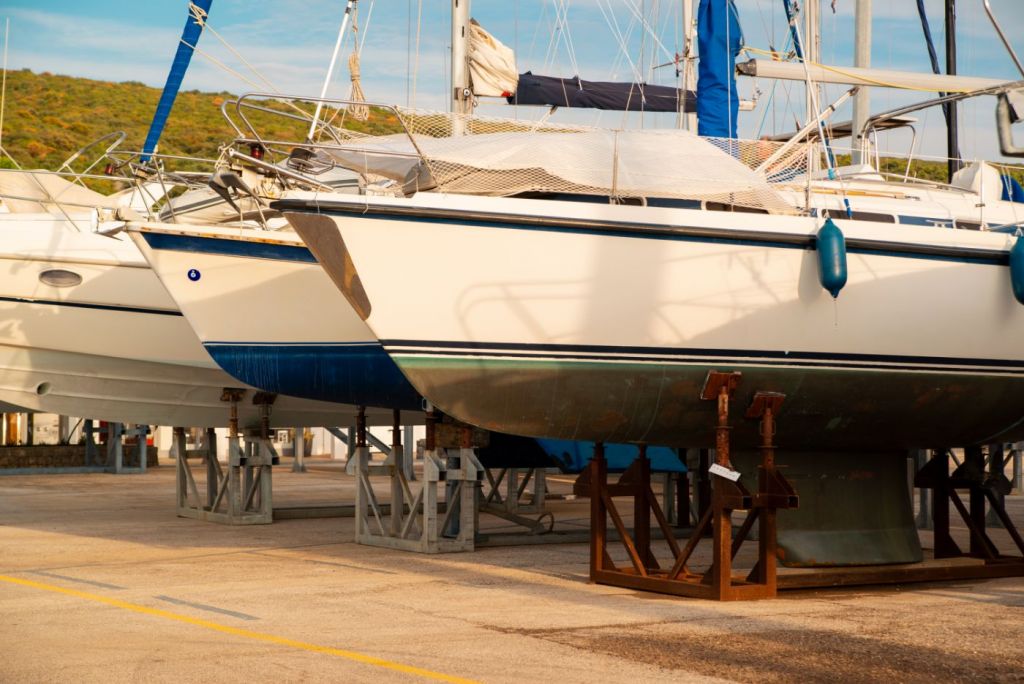
On this page:
Pros and cons of 13 types of keel, canting keel, centreboard, daggerboard, lifting keel, scheel keel.
| Pros | Cons | |
|---|---|---|
| Increased stability, durability, and better tracking | Reduced maneuverability and slower speeds | |
| Improved performance, maneuverability, and ease of maintenance | Less stability, structural vulnerability, less comfortable | |
| Excellent stability, speed and agility, upwind sailing | Increased maintenance, deeper draft | |
| Increased stability, enhanced performance and versatility | Complexity and cost, increased vulnerability to grounding | |
| Flexibility in navigating shallow waters, and adjustable performance | Less stability, regular maintenance, and reduced interior space | |
| Versatility and ease of transport | Reduced performance, additional maintenance, and extra weight | |
| Shallow draft, good upwind performance, and ease of grounding and recovery | Reduced pointing ability, increased leeway, increased maintenance | |
| Shallow draft, low maintenance, self-righting, beaching ability | Reduced performance, larger heeling angle, less stability | |
| Improved maneuverability, ease of maintenance, lighter in weight | Limited righting moment, reduced space, water noise | |
| Better stability, improved upwind performance, low-maintenance | Depth, less maneuverable at slower speeds, heavier and harder to trailer | |
| Versatility, improved performance, easier transportation | Maintenance and complexity, added weight | |
| Improved stability and upwind performance | Larger draft and vulnerability to grounding | |
| Stability, shallow draft, and efficient upwind sailing | Decreased speed and increased maintenance |
If you're curious what these keel types look like, here's our illustrated guide on sailboat keels .
Full-length keel : Full-length keels run the entire length of the boat. They offer excellent stability and are popular among offshore cruisers who require a solid, rugged sailboat. Full keeled boats are better suited for heavy weather, but they may be slower due to their weight and drag.
Fin keel : Fin keels are thinner and generally used for racing, as they provide a good balance between speed and stability. Their reduced drag means faster speeds but might be less stable compared to full-length keels in heavy seas.
Bulb keel : A bulb keel features a heavy, rounded weight at the bottom of the fin keel. This extra weight lowers the boat's center of gravity and provides additional stability without significantly increasing drag.
Canting keel : A canting keel is a high-performance feature that can pivot from side to side, allowing the boat to maintain optimal stability while heeling over on its side to maximize speed in racing scenarios.
Centerboard : This keel type features a retractable board that can be lowered for sailing upwind and raised in shallow waters. Centerboards are often found on smaller boats and dinghies.
Swing keel : Swing keels operate on a hinge, swinging up and down to adjust the boat's draft. They balance the benefits of a larger keel with the convenience of a shallow draft for docking and beaching.
Wing keel : Wing keels are similar to bulb keels but with two small wings on either side of the bulb. These wings increase the effective surface area, offering better stability and shallower draft capabilities, ideal for coastal cruising.
Bilge keel : Bilge keels are found on boats with two smaller keels on either side of the hull rather than a single central keel. This design is most commonly used in tidal waters and on small fishing boats, allowing the boat to sit upright when grounded during low tide.
Daggerboard : Similar to a centerboard, a daggerboard is a non-weighted, removable board that slides vertically through a slot in the hull. This type is also commonly seen on dinghies and smaller sailboats.
Fixed keel : Fixed keel provides good stability and is less prone to damage than other keel types. However, it can limit the boat's ability to sail in shallow waters and may make it more difficult to trailer the boat.
Lifting keel : A lifting keel can be raised or lowered, providing both the benefits of a deep keel for improved stability and performance and a shallow draft for easier access to shallow waters and docking.
T-keel : T-keels provide improved stability and upwind performance, which can be desirable for sailors. However, their larger draft and vulnerability to grounding should be considered when deciding if this keel type is the right choice for your sailing adventures.
Scheel keel : This offers unique benefits, and it could be an excellent choice for your sailboat if you prioritize stability, shallow draft, and efficient upwind sailing. However, you should consider the potential drawbacks, such as decreased speed and increased maintenance, before making a final decision.
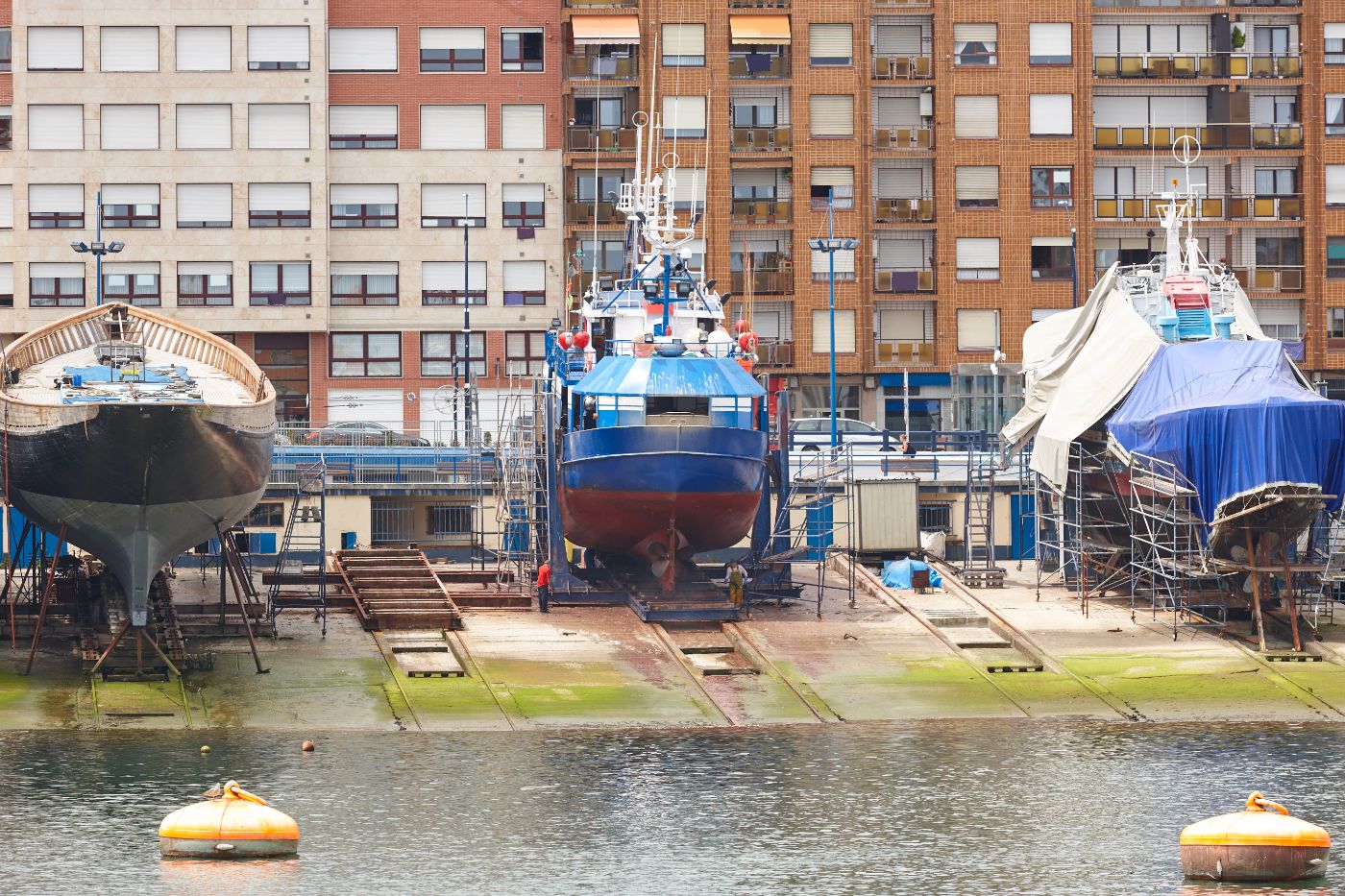
Pros of full keel
A full keel has several advantages that make it an appealing option for many sailors. First and foremost, it offers exceptional stability , which is particularly important when you're out at sea for extended periods. With a full keel, your sailboat can better resist the forces acting on the sails, ensuring a smoother and safer journey.
Another significant benefit is the durability of a full keel. Because of the large surface area and the way it's constructed, full keels tend to be very strong and resilient, making them perfect for long-distance cruising. Additionally, this type of keel provides excellent tracking , helping your sailboat stay on course in various conditions.
Lastly, full keel sailboats are less likely to be damaged when grounding , as the keel's large surface area allows for better weight distribution. This characteristic can be especially useful when navigating shallow waters or exploring uncharted territories.
Cons of full keel
Despite the many advantages of a full keel, it also has some drawbacks. One of the most noticeable disadvantages is its effect on sailboat performance. Full keels tend to be less maneuverable than other keel types, which can be a drawback in tight situations or when you need to make quick adjustments during sailing.
Another downside is the increased wetted surface area, which leads to higher drag and slower speeds when compared to other keel types, such as fin keels. This reduced efficiency can be a concern, especially for those who prioritize performance and speed on their sailing journeys.
Additionally, full keel sailboats may be more challenging to maneuver in tight spaces , such as crowded marinas, due to their reduced maneuverability and larger turning radius. This can make docking and mooring more complex, particularly for inexperienced sailors.
Pros of fin keel
Fin keels hold several advantages for sailors. First, they offer improved performance. A fin keel's streamlined shape cuts through the water more efficiently, allowing sailboats to reach higher speeds with less drag. Moreover, fin keels generally provide better upwind performance than other keel types.
Their maneuverability is another significant benefit. Fin keels allow sailboats to turn more quickly and easily, making them nimble in tight spaces and responsive to the helm. Additionally, they typically have a reduced draft, meaning they can navigate shallow waters more effectively than boats with deeper keels.
Lastly, fin keels are popular for their ease of maintenance . Since they're typically bolted onto the hull, routine inspections and potential repairs are relatively straightforward and accessible.
Cons of fin keel
Despite the benefits, there are a few drawbacks to consider when it comes to fin keels. First, they tend to have less stability than full or bilge keels. Their slender design and reduced weight can make them more prone to sudden heeling, which some sailors may find uncomfortable or disconcerting.
Another potential issue is structural vulnerability . If a fin keel strikes a submerged obstacle, such as a rock or shipping container, it may suffer damage or even become dislodged, which could pose a significant risk to the integrity of the boat. This stands in contrast to more robust full keels, which can better absorb the impact of groundings or collisions.
Lastly, fin keels are sometimes considered less comfortable for cruising sailors. Due to their design, boats with fin keels can experience more motion (both side-to-side and up and down) in rough seas, potentially leading to discomfort or seasickness for the crew.

A bulb keel is a type of sailboat keel that features a streamlined fin with a bulb-shaped weight at the bottom. This design aims to improve the boat's performance, especially in racing conditions. In this section, we will explore the pros and cons of bulb keels.
Pros of bulb keel
Stability : The main advantage of a bulb keel is its ability to provide excellent stability. The bulb's weight is concentrated at its lowest point, which lowers the center of gravity of your sailboat. This design helps keep the boat upright and stable when sailing, especially in strong winds.
Performance : Bulb keels contribute to a sailboat's overall performance by reducing drag. The streamlined shape of the fin and the placement of the bulbous weight make it easier for your boat to glide through the water, increasing your overall speed and agility when sailing.
Upwind sailing : A bulb keel allows your sailboat to sail more effectively upwind. By reducing leeway and maintaining a consistent course, your boat can navigate better through a variety of wind conditions.
Cons of bulb keel
Maintenance : One potential downside of a bulb keel is the increased maintenance required. The bulbs can be more prone to collecting marine growth, which may necessitate regular cleaning and antifouling treatments to maintain peak performance.
Depth : Bulb keels, due to their design, have a deeper draft than other keel types. This means that your sailboat might struggle in shallow waters or require extra diligence while sailing in areas with submerged obstacles or coral reefs.
Pros of canting keel
Canting keels are a popular choice among performance-oriented sailors due to their remarkable benefits in several areas. They offer increased stability and enhanced performance , especially when sailing upwind. This type of keel allows the boat to maintain a more upright position when healing, reducing drag and improving your overall speed and efficiency on the water.
Moreover, canting keels are adjustable , which allows you to alter the keel angle depending on the wind conditions and desired performance. This flexibility can make a significant difference in how your boat performs on the water. Another advantage of canting keels is their improved handling characteristics , which make them easier to maneuver in various conditions.
Cons of canting keel
Despite the many advantages, there are also some notable drawbacks to using a canting keel. One significant downside is their complexity and cost . These keels often require sophisticated engineering and systems, which can drive up the overall price of your boat and may require more maintenance and repairs over time.
Another potential issue with canting keels is their increased vulnerability to grounding . Since the keel can extend deeper beneath the boat, there is a higher risk of hitting obstacles or running aground, especially in shallow waters or unknown territories.
Lastly, canting keels can contribute to changes in the boat's handling characteristics , particularly when sailing downwind. While their adjustability may enhance upwind performance, it may also lead to instability and increased difficulty controlling your boat in heavy downwind conditions.
Pros of the centerboard
A centerboard is a movable keel that can be retracted or lowered to provide stability and balance to your sailboat. Here are some benefits you can enjoy with a centerboard:
- Shallow draft : With a centerboard, you can easily navigate shallow waters and get closer to shore. This is particularly useful for exploring coves, anchorages, and beaching your boat.
- Adjustable performance : By adjusting the position of the centerboard, you can fine-tune your sailboat's performance based on the current sailing conditions.
- Easier transport and storage : Retractable centerboards make it simple to trailer your sailboat and store it in tight spaces without worrying about a fixed keel's height or depth.
- Grounding protection : In case of accidental grounding, a centerboard can help minimize potential damage by absorbing the impact instead of transferring it to your boat's hull.
If you're torn between centerboard, swing, and fixed keels , here's our in-depth article on their pros and cons.
Cons of the centerboard
Despite the advantages, centerboards also come with some drawbacks that you should consider:
- Less stability : When compared to fixed keels, centerboards offer less stability, especially for larger sailboats. This may lead to reduced performance in rough waters or strong winds.
- Maintenance : Centerboards require regular maintenance to ensure they remain functional and efficient. This may include cleaning, lubricating, and inspecting the related components.
- Complexity : The moving parts and additional mechanisms in a centerboard system can be more complex than a fixed keel, potentially increasing the likelihood of mechanical issues.
- Reduced interior space : Depending on your sailboat's design, the presence of a centerboard trunk may limit the available interior space, impacting your comfort and storage options.
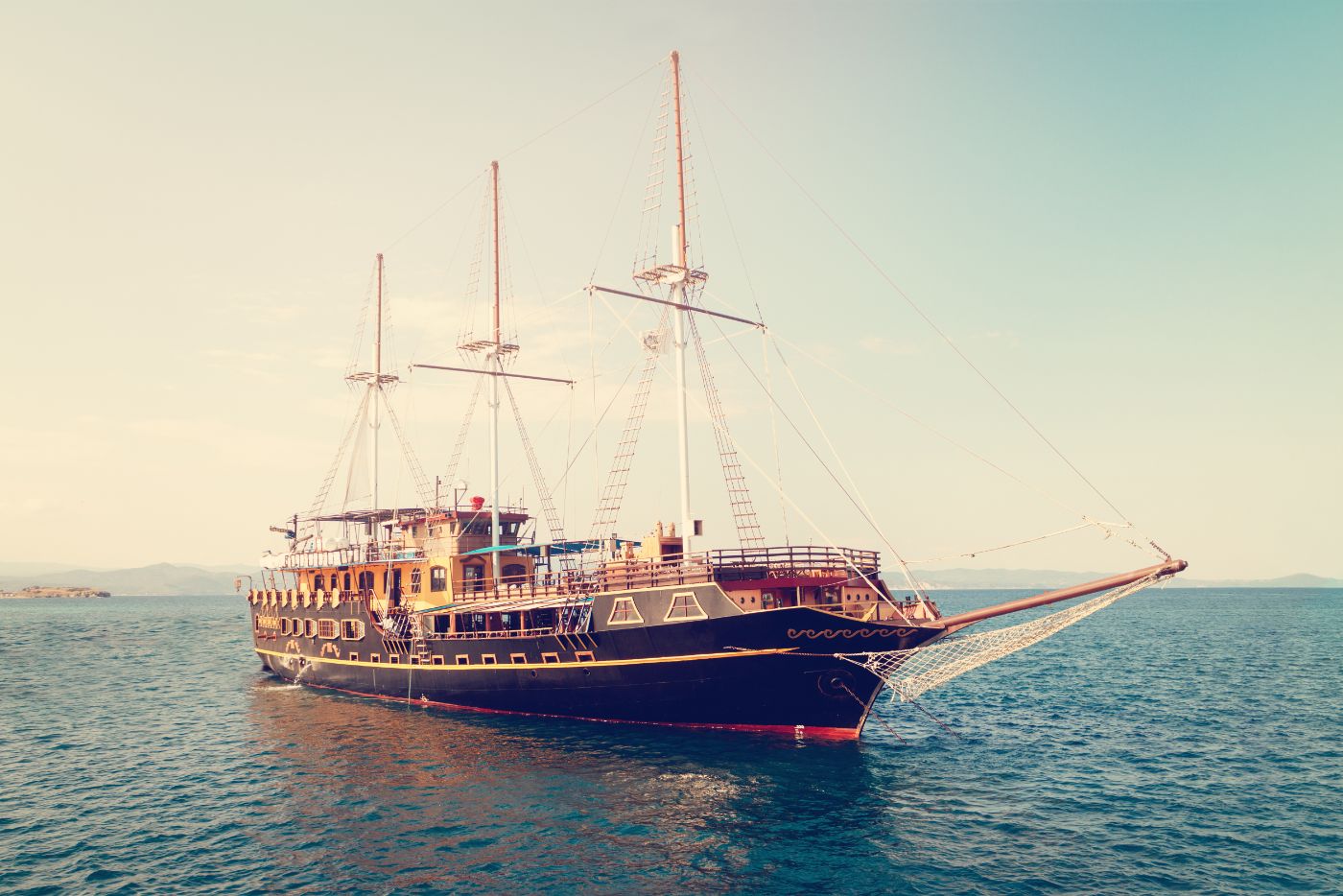
The swing keel is a type of sailboat keel that essentially pivots on a hinge or bolt, allowing the keel to swing up or down as needed. This feature grants a sailboat with a swing keel the ability to adjust its performance and stability depending on the sailing conditions or water depth. Let's discuss the pros and cons of swing keels in detail.
Pros of swing keel
Versatility : The swing keel's ability to pivot grants your sailboat the capability to navigate shallow waters and safely beach your boat without getting stuck. This is advantageous for exploring coastal areas and coves.
Adjustability : Swing keels provide the opportunity for better control over your boat's performance. By adjusting the keel angle, you can find the right balance of stability and speed tailored to your sailing experience and conditions.
Trailerable : A sailboat with a swing keel can be easily trailered and transported, as the keel can be retracted, reducing the boat's weight, draft, and overall dimensions.
Ease of maintenance : Swing keels are often easier to maintain and repair, as they can be retracted for inspection or servicing without having to haul out the entire boat.
Cons of swing keel
Reduced performance : A trade-off with the swing keel's versatility is that it generally doesn't offer the same level of performance as a fixed keel sailboat, especially when it comes to upwind ability or pointing.
Additional complexity : The presence of a pivot point and moving parts can make swing keels more prone to wear or damage. This can lead to additional maintenance requirements or repairs if not properly cared for.
Increased weight : Given the swing keel's construction, materials, and additional hardware, it can add extra weight to your boat compared to other keel types. This may affect your boat's overall performance.
Potential leaks : Like any keel with moveable parts, a swing keel can introduce the risk of water ingress if the seals or hull are not properly maintained.
Pros of wing keel
The wing keel is an innovative design that has gained popularity among sailors due to its unique features and benefits. One of the main advantages of this keel type is its shallow draft . The horizontal wing allows the keel to have a larger surface area without going as deep as a fin keel of the same size, making it ideal for sailboats navigating shallow waters.
Another benefit of the wing keel is its relatively good upwind performance . While not as efficient as a fin keel, it still performs well in many sailing conditions, offering a great balance between maneuverability and stability.
The ease of grounding and recovery is another plus for the wing keel. Since it has a relatively shallow draft, you are less likely to hit the seabed when navigating shallow waters. Furthermore, if the boat does become grounded, the wing keel design makes it easier to refloat.

Cons of wing keel
However, the wing keel is not without its drawbacks. The most notable disadvantage of this design is its reduced pointing ability compared to fin keels. The wing keel may struggle to sail as close to the wind as a similarly-sized sailboat with a fin keel, which can be a disadvantage when racing or sailing in tight spaces.
A wing keel sailboat may also be prone to increased leeway due to the lower depth and surface area of the keel. This can make the boat more difficult to control in strong winds or challenging sea conditions.
Another issue to consider is the maintenance and cleaning of the wing keel. Due to the horizontal wings, it may be harder to access and clean the keel properly, leading to increased fouling or potential damage.

Bilge keels are an interesting combination of two smaller keels mounted on either side of the hull, which provide stability and added performance benefits in certain conditions. In this section, we will explore the pros and cons of bilge keels on sailboats.
Pros of bilge keel
- Shallow draft : Bilge keels allow you to access shallow water areas, expanding your cruising options. The dual keel design keeps your boat stable in shallow waters, making it ideal for exploring remote destinations, such as tidal estuaries or hidden coves.
- Low maintenance : Compared to other keel types like fin keels or lifting keels, bilge keels require less maintenance. They are sturdy and simpler to maintain due to their fixed position.
- Self-righting : With bilge keels, your sailboat has a natural ability to self-right after a capsize. Their wide footprint provides additional support and stability, reducing the chances of a full capsize.
- Beaching ability : Bilge keel boats can safely dry out on the beach or tidal flats without tipping, making it easier for you to conduct maintenance or give the hull a thorough clean.
Cons of bilge keel
- Reduced performance : While bilge keels offer stability and shallow draft benefits, they can reduce your sailboat's performance in certain conditions. They create more drag, causing your boat to be slower and less agile than boats with fin keels.
- Heeling angle limitations : Due to their wide footprint, bilge keel sailboats experience a larger heeling angle, which could make sailing at high speeds or in strong winds challenging.
- Less upright stability : Bilge keel boats may be less stable when sailing in extreme conditions, as the dual keel design provides less leverage for the boat to lean on compared to a deep fin keel.
Pros of daggerboard
A daggerboard can enhance your sailing experience in several ways. First and foremost, it provides improved maneuverability . With a daggerboard, you can navigate through shallow waters more easily, making it ideal for exploring coastal areas and inland waterways.
Another advantage is the ease of maintenance . Daggerboards are simpler in design compared to other keel types, making them easier to maintain and repair. Additionally, they are easily retractable, allowing you to adjust the draft of your sailboat depending on the depth of the water, avoiding running aground or hitting underwater obstacles.
Daggerboards are also typically lighter in weight compared to other keel types, which contributes to better sailing performance, particularly in light wind conditions. It is also worth noting that their simple design often results in lower production costs for boat manufacturers, resulting in more affordable options for you, the buyer.
Finally, daggerboards are popular on trailer sailers due to their retractable nature, making it more convenient for you to transport your sailboat on a trailer over land when necessary.
Cons of daggerboard
Despite the various advantages, there are a few downsides to consider when it comes to daggerboards. One notable drawback is their limited righting moment . This means that sailboats with a daggerboard are generally less stable and more prone to heeling or even capsizing in rough conditions. If you frequently sail in choppy waters, this could be a significant concern for your safety.
Another downside is the space occupied by the daggerboard case inside the cabin of the boat. This can reduce the available living space, especially on smaller sailboats. In addition, daggerboards can be noisier than other keel types when sailing due to water noise around the daggerboard case.
Lastly, the lack of keel protection in boats with daggerboards makes them more vulnerable to damage by underwater obstacles. While the retractability feature might mitigate this risk somewhat, it is still essential for you to remain cautious when navigating shallow and uncharted waters.
Pros of fixed keel
A fixed keel offers numerous advantages that can make your sailing experience more enjoyable. First, fixed keels provide better stability as they have a lower center of gravity, resulting in a more comfortable ride. This is particularly beneficial when sailing in rough weather or choppy seas.
Moreover, fixed keels offer improved upwind performance compared to other keel types. The deeper draft allows the boat to generate more lift and point higher into the wind, making it faster and more efficient when sailing upwind. Additionally, these keels are low-maintenance since there are fewer moving parts to wear out or require replacement.
Lastly, fixed keel boats tend to have better handling under power . They can make precise turns and handle well in reverse, allowing for easier maneuvering in tight spaces and marinas.
Cons of fixed keel
Despite their advantages, fixed keels also come with some drawbacks. One of the main concerns is their depth , which limits the boat's ability to access shallow waters. This may restrict your sailing options, especially near shorelines or in tidal areas.
Additionally, fixed keel boats can be less maneuverable at slower speeds compared to boats with swing keels or centerboards. This can make tight turns more challenging, especially in crowded harbors or narrow waterways.
Finally, fixed keel boats are generally heavier and harder to trailer , as they require a higher towing capacity and specially designed trailers to accommodate the boat's deeper draft. This added weight can make transportation more difficult and lead to higher fuel costs for road transportation.
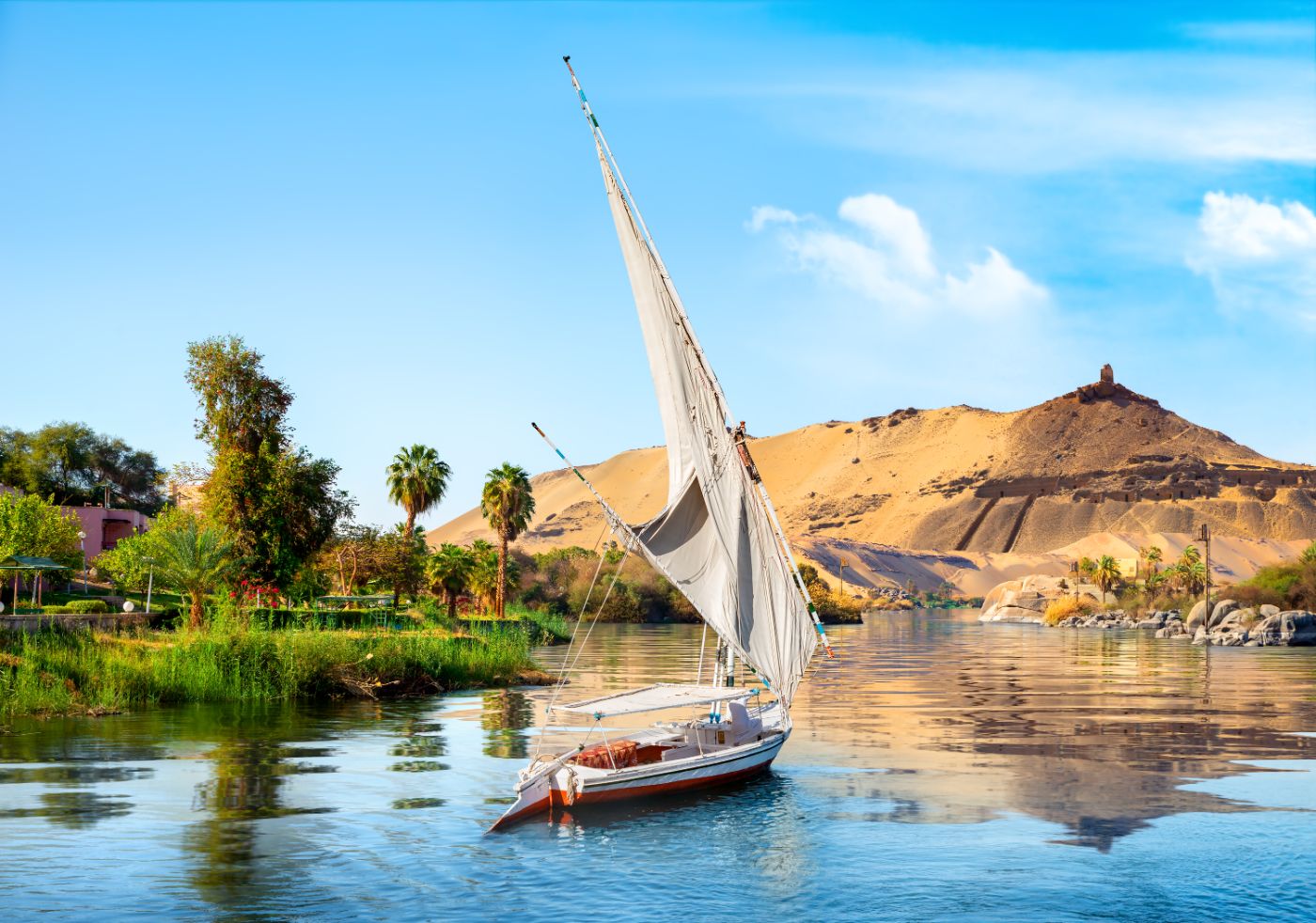
Pros of lifting keel
A lifting keel is a type of keel that can be raised or lowered, allowing you to adjust the depth and balance of your sailboat. When properly utilized, a lifting keel can provide a number of benefits to enhance your sailing experience.
- Versatility : A lifting keel allows you to sail in shallow waters as well as access ports and harbors with limited depth. This is especially useful for exploring coastal areas and navigating tidal waters.
- Improved performance : By adjusting the depth of the keel, you can optimize your boat's performance in various sailing conditions. This can result in better speed, stability, and upwind performance.
- Easier transportation : With the ability to raise the keel, transporting your sailboat on a trailer becomes more manageable as it reduces the overall draft and height of your boat.
If you're choosing between swing or lifting keel , here's our more detailed guide on their pros and cons.
Cons of lifting keel
While a lifting keel offers several advantages, it is essential to be aware of some potential drawbacks before choosing this type of keel for your sailboat.
- Maintenance and complexity : Lifting keels typically require more maintenance due to the moving parts involved. Extra care is needed to inspect and maintain the keel's lifting mechanism, which might include a winch, cable, or hydraulic system.
- Added weight : The lifting mechanism adds weight to your boat, which can have negative effects on performance and fuel efficiency.
- Potential weaknesses : The structural integrity of a boat with a lifting keel can be compromised if it is not designed and engineered properly. This could lead to stress points or even failure in extreme situations.
Pros of T-keel
T-keel is a unique design that has its advantages to consider. First, it offers improved stability . With a heavier weight concentrated at the bottom of the keel, your sailboat will resist heeling, maintaining a more upright position in strong winds. This added stability allows for better control and a smoother ride when sailing.
Another pro of the T-keel is its powerful upwind performance . The shape and design of this keel allow for a low center of gravity while minimizing drag. This combination helps your sailboat efficiently point into the wind, allowing for a quicker upwind speed. This increased performance can make a difference when racing or navigating through tight spaces.
Cons of T-keel
However, T-keels are not without their drawbacks. One potential downside is that T-keel boats tend to have a larger draft than other types of keels, meaning they require deeper water for sailing. This can restrict your ability to sail in shallow waters around bays or near shorelines, limiting your access to certain areas.
Another drawback of T-keels is that they can be more prone to grounding due to their design. If you accidentally run aground or hit an underwater object, the T-keel may be more likely to experience damage or become difficult to dislodge. This can lead to costly repairs or complications when trying to free your sailboat.
The Scheel Keel is a unique keel type that was designed by naval architect Henry Scheel in the 1970s. This keel offers a compromise between performance and stability, making it a popular choice for many sailboat owners. In this section, we'll discuss the pros and cons of the Scheel Keel to help you decide if it's the right choice for your sailing needs.
Pros of Scheel keel
Shallow draft : One of the main advantages of the Scheel Keel is its shallow draft. This allows you to navigate in shallower waters, making it easier to access more anchorage spots and enjoy cruising in coastal areas.
Stability : With its wide, flat bottom, the Scheel Keel provides good stability, making your sailboat feel more secure and comfortable in various conditions. This can be especially beneficial for less experienced sailors or those who prefer a more stable ride.
Efficient upwind performance : The Scheel Keel is designed to improve upwind performance without sacrificing stability. This means you can sail more efficiently and at a better angle to the wind, which can be a noticeable advantage in many sailing situations.
Cons of Scheel keel
Potential for decreased speed : Due to its wide, flat bottom, the Scheel Keel can create more drag, which may decrease your overall speed in comparison to other keel types. While the Scheel Keel offers improved upwind performance, it may not be the best choice for you if maximizing speed is your primary concern.
Maintenance : The unique shape of the Scheel Keel can make it more susceptible to damage, particularly if you frequently sail in shallow waters or near shorelines with rocks and other hazards. As a result, you might need to pay closer attention to the maintenance and repair of your keel.
Limited availability : While many sailors appreciate the benefits of the Scheel Keel, it's not as widely available as some other keel designs. This could make it more difficult for you to find a sailboat with a Scheel Keel or to have one retrofitted to your current boat.
Leave a comment
You may also like, sailboat keel types: illustrated guide (bilge, fin, full).
The keel type is one of the most important features of your boat. But the different designs can be confusing, so I've set out to create a very clear guide that will …
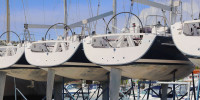
Centerboard (Swing Keel) vs. Fixed Keel: Pros and Cons

What is a Swing or Lifting Keel? 14 Pros and Cons Explained
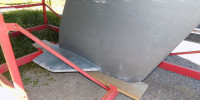
Pros and Cons of the Wing Keel (5 Surprising Benefits)
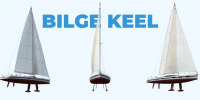
Pros and Cons of the Bilge Keel (5 Surprising Benefits)
Your cart is empty
Have an account?
Log in to check out faster.
CHECK OUT OUR NEW REFERRAL PROGRAMME FOR REMO FRIENDS & FAMILY

Country/region
- Afghanistan (USD $)
- Åland Islands (USD $)
- Albania (USD $)
- Algeria (USD $)
- Andorra (EUR €)
- Angola (USD $)
- Anguilla (USD $)
- Antigua & Barbuda (USD $)
- Argentina (USD $)
- Armenia (USD $)
- Aruba (USD $)
- Ascension Island (USD $)
- Australia (AUD $)
- Austria (EUR €)
- Azerbaijan (USD $)
- Bahamas (USD $)
- Bahrain (USD $)
- Bangladesh (USD $)
- Barbados (USD $)
- Belarus (USD $)
- Belgium (EUR €)
- Belize (USD $)
- Benin (USD $)
- Bermuda (USD $)
- Bhutan (USD $)
- Bolivia (USD $)
- Bosnia & Herzegovina (USD $)
- Botswana (USD $)
- Brazil (USD $)
- British Indian Ocean Territory (USD $)
- British Virgin Islands (USD $)
- Brunei (USD $)
- Bulgaria (BGN лв.)
- Burkina Faso (USD $)
- Burundi (USD $)
- Cambodia (USD $)
- Cameroon (USD $)
- Canada (CAD $)
- Cape Verde (USD $)
- Caribbean Netherlands (USD $)
- Cayman Islands (USD $)
- Central African Republic (USD $)
- Chad (USD $)
- Chile (USD $)
- China (CNY ¥)
- Christmas Island (USD $)
- Cocos (Keeling) Islands (USD $)
- Colombia (USD $)
- Comoros (USD $)
- Congo - Brazzaville (USD $)
- Congo - Kinshasa (USD $)
- Cook Islands (NZD $)
- Costa Rica (USD $)
- Côte d’Ivoire (USD $)
- Croatia (EUR €)
- Curaçao (USD $)
- Cyprus (EUR €)
- Czechia (CZK Kč)
- Denmark (DKK kr.)
- Djibouti (USD $)
- Dominica (USD $)
- Dominican Republic (USD $)
- Ecuador (USD $)
- Egypt (USD $)
- El Salvador (USD $)
- Equatorial Guinea (USD $)
- Eritrea (USD $)
- Estonia (EUR €)
- Eswatini (USD $)
- Ethiopia (USD $)
- Falkland Islands (USD $)
- Faroe Islands (USD $)
- Fiji (USD $)
- Finland (EUR €)
- France (EUR €)
- French Guiana (USD $)
- French Polynesia (USD $)
- French Southern Territories (USD $)
- Gabon (USD $)
- Gambia (USD $)
- Georgia (USD $)
- Germany (EUR €)
- Ghana (USD $)
- Gibraltar (GBP £)
- Greece (EUR €)
- Greenland (USD $)
- Grenada (USD $)
- Guadeloupe (USD $)
- Guatemala (USD $)
- Guernsey (GBP £)
- Guinea (USD $)
- Guinea-Bissau (USD $)
- Guyana (USD $)
- Haiti (USD $)
- Honduras (USD $)
- Hong Kong SAR (HKD $)
- Hungary (HUF Ft)
- Iceland (USD $)
- India (INR ₹)
- Indonesia (USD $)
- Iraq (USD $)
- Ireland (EUR €)
- Isle of Man (GBP £)
- Israel (USD $)
- Italy (EUR €)
- Jamaica (USD $)
- Japan (JPY ¥)
- Jersey (AUD $)
- Jordan (USD $)
- Kazakhstan (USD $)
- Kenya (USD $)
- Kiribati (USD $)
- Kosovo (USD $)
- Kuwait (USD $)
- Kyrgyzstan (USD $)
- Laos (USD $)
- Latvia (EUR €)
- Lebanon (USD $)
- Lesotho (USD $)
- Liberia (USD $)
- Libya (USD $)
- Liechtenstein (CHF CHF)
- Lithuania (EUR €)
- Luxembourg (EUR €)
- Macao SAR (MOP P)
- Madagascar (USD $)
- Malawi (USD $)
- Malaysia (USD $)
- Maldives (USD $)
- Mali (USD $)
- Malta (EUR €)
- Martinique (USD $)
- Mauritania (USD $)
- Mauritius (USD $)
- Mayotte (USD $)
- Mexico (USD $)
- Moldova (USD $)
- Monaco (EUR €)
- Mongolia (USD $)
- Montenegro (USD $)
- Montserrat (USD $)
- Morocco (USD $)
- Mozambique (USD $)
- Myanmar (Burma) (USD $)
- Namibia (USD $)
- Nauru (USD $)
- Nepal (USD $)
- Netherlands (EUR €)
- New Caledonia (USD $)
- New Zealand (NZD $)
- Nicaragua (USD $)
- Niger (USD $)
- Nigeria (USD $)
- Niue (NZD $)
- Norfolk Island (USD $)
- North Macedonia (USD $)
- Norway (USD $)
- Oman (USD $)
- Pakistan (USD $)
- Palestinian Territories (USD $)
- Panama (USD $)
- Papua New Guinea (USD $)
- Paraguay (USD $)
- Peru (USD $)
- Philippines (USD $)
- Pitcairn Islands (USD $)
- Poland (PLN zł)
- Portugal (EUR €)
- Qatar (USD $)
- Réunion (USD $)
- Romania (RON Lei)
- Russia (USD $)
- Rwanda (USD $)
- Samoa (USD $)
- San Marino (EUR €)
- São Tomé & Príncipe (USD $)
- Saudi Arabia (USD $)
- Senegal (USD $)
- Serbia (USD $)
- Seychelles (USD $)
- Sierra Leone (USD $)
- Singapore (USD $)
- Sint Maarten (USD $)
- Slovakia (EUR €)
- Slovenia (EUR €)
- Solomon Islands (USD $)
- Somalia (USD $)
- South Africa (USD $)
- South Georgia & South Sandwich Islands (USD $)
- South Korea (USD $)
- South Sudan (USD $)
- Spain (EUR €)
- Sri Lanka (USD $)
- St. Barthélemy (USD $)
- St. Helena (USD $)
- St. Kitts & Nevis (USD $)
- St. Lucia (USD $)
- St. Martin (USD $)
- St. Pierre & Miquelon (USD $)
- St. Vincent & Grenadines (USD $)
- Sudan (USD $)
- Suriname (USD $)
- Svalbard & Jan Mayen (USD $)
- Sweden (SEK kr)
- Switzerland (CHF CHF)
- Taiwan (USD $)
- Tajikistan (USD $)
- Tanzania (USD $)
- Thailand (USD $)
- Timor-Leste (USD $)
- Togo (USD $)
- Tokelau (NZD $)
- Tonga (USD $)
- Trinidad & Tobago (USD $)
- Tristan da Cunha (USD $)
- Tunisia (USD $)
- Türkiye (USD $)
- Turkmenistan (USD $)
- Turks & Caicos Islands (USD $)
- Tuvalu (USD $)
- U.S. Outlying Islands (USD $)
- Uganda (USD $)
- Ukraine (USD $)
- United Arab Emirates (USD $)
- United Kingdom (GBP £)
- United States (USD $)
- Uruguay (USD $)
- Uzbekistan (USD $)
- Vanuatu (USD $)
- Vatican City (EUR €)
- Venezuela (USD $)
- Vietnam (USD $)
- Wallis & Futuna (USD $)
- Western Sahara (USD $)
- Yemen (USD $)
- Zambia (USD $)
- Zimbabwe (USD $)
The Winged Keel
The America’s Cup is the oldest continuously awarded trophy in the world. It predates the American Civil War. Between 1851 and 1983, the New York Yacht Club (NYYC) had won every race and had even bolted the Cup to a stand in their trophy room. Such was their confidence that the “Auld Mug” would be forever theirs.
But in the 1970s, Australian entrepreneur Alan Bond came up with a plan to unseat it from NYYC’s altar, and enlisted the help of self-taught boat designer and Novacastrian Ben Lexcen.
In May 1983, when the crew of Australia II arrived at the start of the cup in Newport, RI, the eyes of the media locked on the skirt drawn tightly around the keel. Indeed, the design of the boat's keel was a closely guarded secret, but its reputation had preceded it. Lexcen's design featured a reduced waterline length and a winged keel which gave the boat a significant advantage in manoeuvrability and heeling moment (lower ballast centre of gravity). The sailing world was stunned.
The winged keel was a major design advance, and its legality was questioned by the New York Yacht Club. During the summer of 1983, as selection trials took place for the Cup defence that autumn, the club challenged the legality of the keel design. The controversy was ultimately decided in Australia II 's favour.
In the end, the Cup – won by the best of seven races over several weeks – was tied at three-all at the final start line. Australia II ‘s crew battled nerves after a false start, but after swapping the lead with the NYYC’s Liberty three times, ultimately won by 41 seconds.
Back at the dock, Bond ordered the boat to be lifted out of the water to show off the mysterious keel. People jumped into the water to touch it, someone still wearing his dinner suit.
On the other side of the world, sleep-deprived Australians who had been rising day-after-day for the 2:00am AEST starts to the races began to celebrate in earnest. Bob Hawke, the Prime Minister at the time (wearing a jacket of questionable taste) famously declared to the assembled media throng: “I’ll tell you what: any boss who sacks a worker for not turning up today is a bum.”
In 2009, more than two decades after Lexcen's death, Dutch naval architect Peter van Oossanen claimed that the winged keel was actually designed by him and his group of Dutch designers, and not Lexcen. If true, this would have been reason to disqualify Australia II , since the rules then stated that challenging yachts were to be designed only by citizens of the nations they represented. The controversy arose due to Cup rules allowing designers to use model basins for testing that were not located in the challenging country. Model testing was performed in the Netherlands and Peter van Oossanen and another Dutch engineer, Joop Sloof, performed measurements and analyses related to evaluation of winged keel designs.
The suggestion that the vessel was not designed by Australians has been refuted by both Australia II ’s skipper John Bertrand and project manager John Longley. Furthermore, it is well established that Lexcen had been experimenting with wing adaptations to the undersurface appendages of boats before, including his 1958 skiffs Taipan and Venom .
In 1983 Lexcen commented on the design issue: "I have in mind to admit it all to the New York Yacht Club that I really owe the secret of the design to a Greek guy who helped me out and was invaluable. He's been dead for 2000 years. Bloody Archimedes …”
Story Idea: Remo Giuffré _______________________________
wikipedia.org/wiki/Australia_II americascup.com/history/65_THE-CUP-THAT-CHANGED-EVERYTHING lexology.com/library/detail.aspx?g=b0f4e07b-85d8-41a3-abc2-c6eb6c09a5b0 theguardian.com/sport/2009/oct/14/lexcen-americas-cup-keel-australia
1. Australia II at top speed on a three-sail reach on her way to breaking the longest successful cup defence – 132 years - of any sport. Her special invention, the winged keel, can be seen under water. Credit: Dan Nerney, 1983. 2. Ben Lexcen crouching on one of the famous wings of the keel and, mind-blowing at the time, the keel, which weighs probably just over 20 tonnes including the wings, is located upside down on the hull. Credit: Dan Nerney, 1983. 3. Ben's patent application GB 2 114 515 A, cleverly applied for close enough to race time so as to be unpublished during the lead up, thereby preventing a fast copy. 4. The Boxing Kangaroo flag commissioned by Bond that was played every time Australia II was arriving at or leaving the dock. Cue the music: Down Under by Men at Work. Watch the music video HERE . 5. Video : Channel 7 broadcast of Australia II winning 1983 America's Cup 6. Prime Minister Bob Hawke wearing that jacket. Photo: News Ltd/Newspix. 7. Alan Bond celebrates with the "Auld Mug" 8. Video : Australia II and the 1983 America's Cup Victory, The Sydney Morning Herald and The Age recap 9. Australia II with its winged keel on display at the WA Maritime Museum
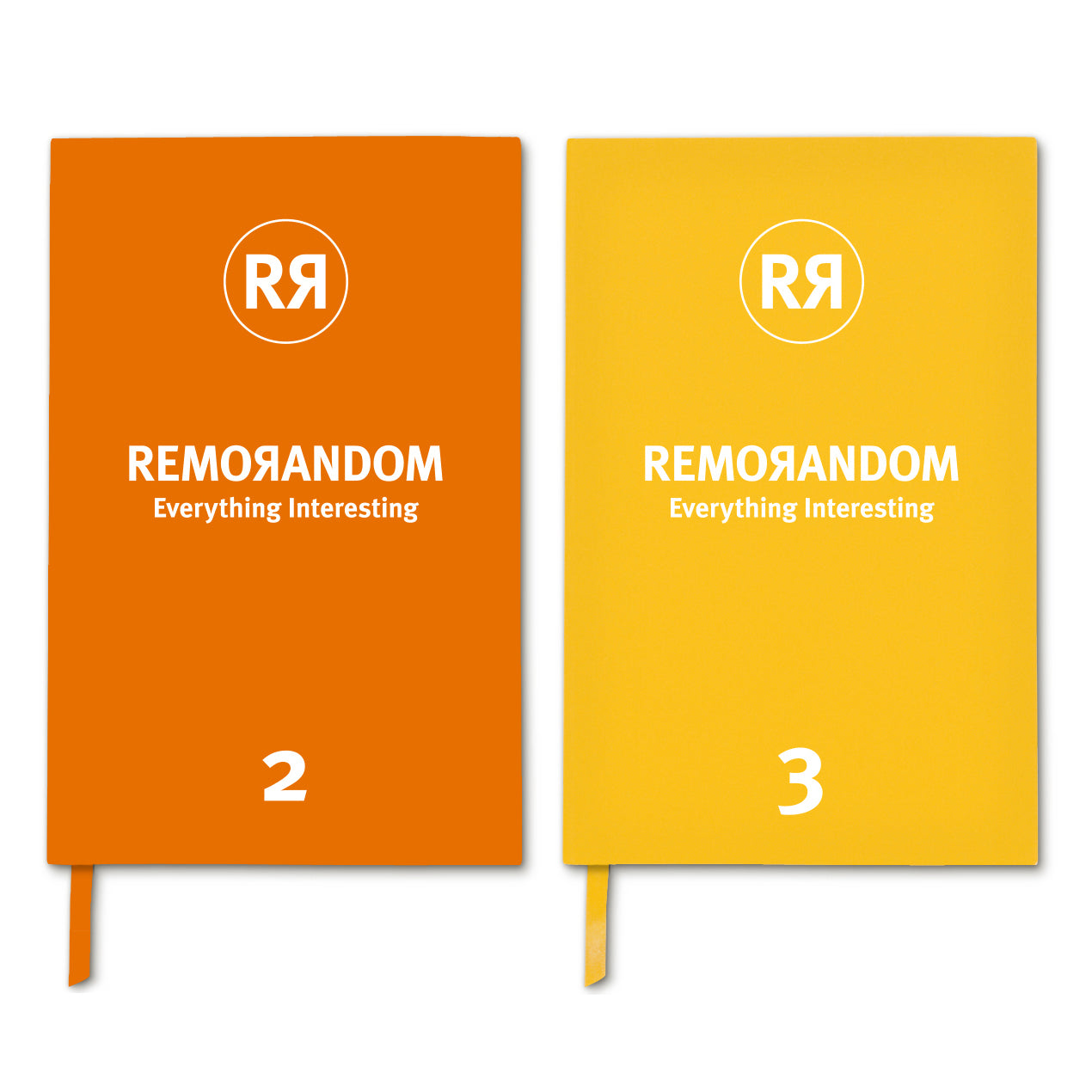
REMORANDOM Subscription

REMORANDOM #1
All active Subscribers to REMORANDOM (biannual book series) enjoy VIP pricing by using SUB24 code. Subscribe HERE .

REMORANDOM #2
- Choosing a selection results in a full page refresh.
- Opens in a new window.
- New Sailboats
- Sailboats 21-30ft
- Sailboats 31-35ft
- Sailboats 36-40ft
- Sailboats Over 40ft
- Sailboats Under 21feet
- used_sailboats
- Apps and Computer Programs
- Communications
- Fishfinders
- Handheld Electronics
- Plotters MFDS Rradar
- Wind, Speed & Depth Instruments
- Anchoring Mooring
- Running Rigging
- Sails Canvas
- Standing Rigging
- Diesel Engines
- Off Grid Energy
- Cleaning Waxing
- DIY Projects
- Repair, Tools & Materials
- Spare Parts
- Tools & Gadgets
- Cabin Comfort
- Ventilation
- Footwear Apparel
- Foul Weather Gear
- Mailport & PS Advisor
- Inside Practical Sailor Blog
- Activate My Web Access
- Reset Password
- Customer Service

- Free Newsletter

Mason 33 Used Boat Review

Beneteau 311, Catalina 310 and Hunter 326 Used Boat Comparison

Maine Cat 41 Used Boat Review

Cheoy Lee Clipper 36 & 42 Used Boat Review

Tips From A First “Sail” on the ICW

Tillerpilot Tips and Safety Cautions

Best Crimpers and Strippers for Fixing Marine Electrical Connectors

Thinking Through a Solar Power Installation

Stopping Mainsheet Twist

Working with High-Tech Ropes

Getting a Clue for the Blown-Out Clew

Monel Seizing Wire is Worth the Extra Cost

Fuel Lift Pump: Easy DIY Diesel Fuel System Diagnostic and Repair

Ensuring Safe Shorepower

Sinking? Check Your Stuffing Box

The Rain Catcher’s Guide

Boat Maintenance for the Technically Illiterate: Part 1

Whats the Best Way to Restore Clear Plastic Windows?

Mastering Precision Drilling: How to Use Drill Guides

Giving Bugs the Big Goodbye

Galley Gadgets for the Cruising Sailor

Those Extras you Don’t Need But Love to Have

UV Clothing: Is It Worth the Hype?

Preparing Yourself for Solo Sailing

How to Select Crew for a Passage or Delivery

Preparing A Boat to Sail Solo

On Watch: This 60-Year-Old Hinckley Pilot 35 is Also a Working…

On Watch: America’s Cup

On Watch: All Eyes on Europe Sail Racing

Dear Readers

Chafe Protection for Dock Lines
- Inside Practical Sailor
What is the Best Keel for A Shoal Draft Boat?

The popularity of our recent discussion of shoal draft boats prompted a dive into the archives on related topics, and we were delighted to see the name Warwick Collins pop up. Collins, the inventor of the tandem or “Collins keel,” died in 2013, but his name frequently appears up in boat design forums today. For those unfamiliar with Collins, he was typical of the eccentric personalities who often rise to the top in the field of sailboat design—a creative genius whose talents spread into a wide range of forums. In Collins case, the pursuits included poet, novelist, evolutionary biologist, and naval architect. And of course, inventor of the Collins keel—a design which incorporated two efficient foils joined by a ballasted foot. Do a Google image search for “Collins keel,” and you’ll see several variations .
The fact that this PS Advisor Q&A from more than three decades ago ( PS January 1989) is just as salient today as it was then (the tandem’s close relative, the canard keel is a fundamental aspect of can’ting keel racing designs today) illustrates how innovation in foil and hull forms still relies as much on the imagination of creative geniuses like Collins as it does on computer algorithms.
One shallow-draft keel form that this article doesn’t mention is the bilge keel, which is seeing a bit of a resurgence today. Also missing is the ancient leeboard design. If you are the proud owner of a bilge-keeler or leeboard boat, we’d be interested in hearing from you in the comments below, or e-mailing us at [email protected] .
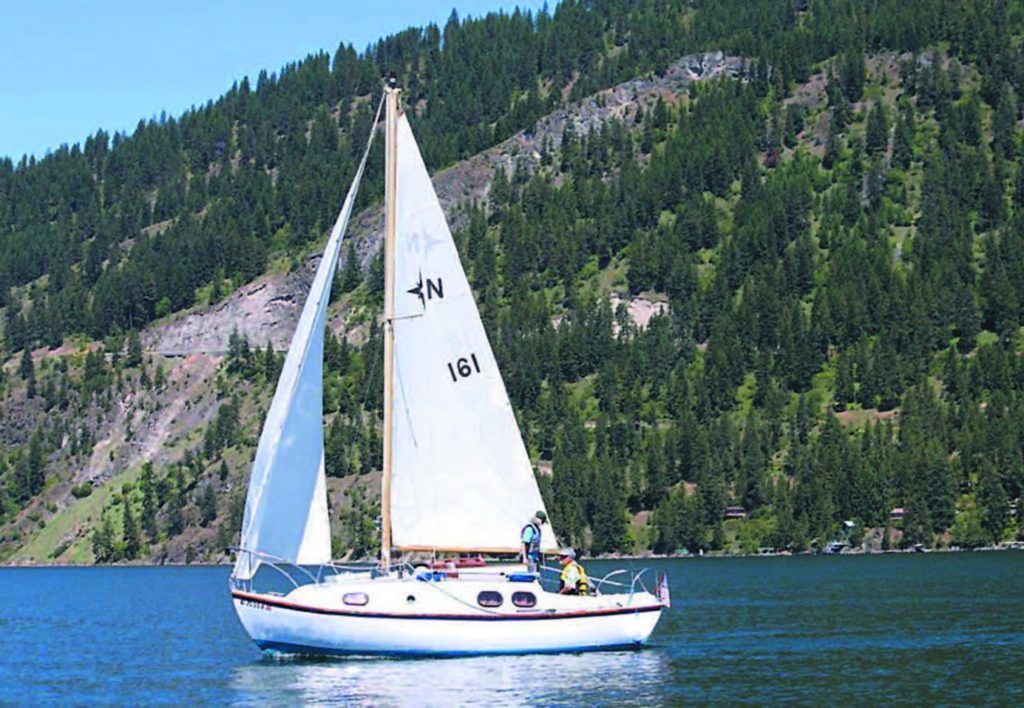
Here’s the original excerpt from PS Advisor January 1989, featuring a question from a reader in Tampa, FL, where shoal draft can greatly expand cruising grounds:
I read your comments on the shoal draft tandem or canard keel by the Englishman Warwick Collins. While you praised the keel, you really didn’t answer the main question for those of us who are looking for a new boat with shoal draft.
Which is the preferred keel for shoal draft? Wing? Scheel? Collins? Centerboard? The old-fashioned long, shallow keel?
Part of it depends on the hull. You can’t just stick any keel onto any hull-there has to be a marriage between the two. The long shoal keel, for example, would be a disaster as a replacement for the fin on a typical modem flat-bottom hull, and the fin a disaster on the deeper, round-bottom hull. So the following comments assume that there’s a satisfactory union between hull and keel. Practical Sailor published an in-depth report on keel-hull connections in the wake of recent failures.
We think the Collins or canard keel looks promising, but we’d have to say it is still not adequately proven. It probably does offer better performance than a conventional keel of the same depth, but it’s not clear that its performance is superior to the other shoal-draft options. There’s also a bit of structural concern with the keel, in that it just about has to be made of iron or steel to have sufficient strength. Wing keels have some of the same problem, but a lead version of the Collins keel could probably deform badly in a hard grounding.
We remain skeptical of the wing keel. While a well-designed one can perform comparably to other shoal-draft keels, we see many wings that are questionable. We walked through the New York Boat Show in 1989 with a naval architect who had designed wing keels for the America’s Cup boats, and his judgment was that every wing at the show was poorly done—sometimes appearing less efficient than a wingless keel of the same depth. In addition, of course, you always have the potential problem of snagging lobster pots or kelp, especially with wing keels that have reverse slope front edges (which they apparently need to be truly efficient).
The Scheel keel is pretty well proven by this time. We think it’s a better bet than the wing, if you have that choice, and overall a good moderate design for shallow-draft cruising. Performance isn’t bad-in racing, both PHRF and IMS show that the Scheel keel is about 5 to 12 seconds per mile slower than a deeper fin on otherwise identical boats.
However, we think the best bet is the modern keel/centerboard. Unlike centerboards of 20 years ago, the new ones are very efficient going to windward with the boards down and not all that bad with the boards partially raised or withdrawn into a stub keel.
For the two boats we’ve recently sailed on-a C&C and a Sabre—our impression was that even with the board retracted the boats sailed about as well as comparable wing-keelers or Scheel keel boats. Maintenance, especially keeping barnacles and weeds out of the inside of the centerboard case, is a problem, and the tackle to raise and lower the board is a minor complication in rigging.
But otherwise they seem best—good performance with shallow draft, and excellent performance when you drop the board fully. For people who like getting into the nitty gritty of foil design, designer Eric Sponberg produced an informative analysis a while back. Ralph Naranjo also reflected on keel preferences in his in-depth report on keel design .
RELATED ARTICLES MORE FROM AUTHOR
On watch: this 60-year-old hinckley pilot 35 is also a working girl, 12 comments.
The Horizon Cat design by Com-Pac was a good answer to Florida west coast cruising with all the shoal waters. The stub keel provided ballast and together with a small amount of the bilge, provided the centerboard housing without intruding into the living space. The board is long enough for good lateral resistance and provides easy management with a pennant towards the tip led to a clamshell cleat on the cockpit sole. I have been exceptionally happy with the combination (and the early heads up when I wander into shallow water!).
The keel/centerboard on Little Harbors(Ted Hood Sr)—I had a 38 footer for 14 years–was phenomenal. Go to weather?? Like a bullet. Did 4 Regatta D-Amigos races with her(Galveston /Vera Cruz), 620 NM , hard to weather most of the way into strong S/SE winds . She was in Trophy range in each race. Would have a larger one today except they quit making them and the larger ones were/are very expensive.
I sail an 87 Sabre 42 CB. i love the keel…we can point with newer boats with a deep keel such as a 2003 SunFast 37 with the board down, but only draw 5′ with the board up. Yes there are negative aspects, such as the maintenance issues involved, but for us, the benefits have outweighed the negatives.
Everything is a trade off….Is there the best all around design?
I’m a twin-keel sailor in Southern Florida. I’ve owned and sailed four, a Vivacity 20, a Westerly 25 and a pair of Westerly Pageants (23′). I’m based in Sarasota, on the west coast where the Gulf waters are warm and blue, but the estuarine waters are brown and shallow.
Advantages: Stiff: With a roughly 40% ballast ratio, the boats are stiff and can handle real wind without extreme heel. Shallow draft: The Vivacity drew 2 feet, and the Pageant is 2’10”. And both can be run aground without fear. This makes gunk holing an adventure instead of a peril. And no underwater parts to break or shear. Maintenance: pull up on a scenic sandbar and scrape the bottom, a fun summertime enterprise. Just don’t forget to figure out the tides. Stability: one of the Pageants had a vane-only self steering device, with no pendulum or aux rudder in the water. It once made the 48 hour trip from Sarasota’s New Pass to the Dry Tortugas entirely on the vane. A sheet-to-tiller system is almost as reliable, although with more variation due to “system” lag. Volume: by their nature, twin-keep designs are beamier than similar-sized single-keel designs. This provides separation for the keels. Thus interior space is larger, with more storage bins etc. Strength: most twin-keel boats are British, and are built for use in areas with large tidal ranges. Slips must accommodate serious water level changes, and are expensive to rent. Many twin-keelers regularly “take the bottom” on their moorings, day after day after day, with all the associated pounding. Dry: all four of my boats had bilge spaces so dry I could store postage stamps there. Finding water in the bilge was a rare event, usually due to leaving a port or hatch open in a rain. With a dry bilge, mildew was held at bay if you had some through-cabin ventilation. Posture: sits upright when in the boatyard; no jack stands required. Much better stability on a trailer (use a flatbed if you want).
Disadvantages: Speed: more wetted area, so slower. Over the very long haul, I average about 3 knots for planning purposes. Mind you LWL is about 17 feet. Pointing: doesn’t sail well at the “edge” going to windward. Performs best about 50-55 degrees of the wind. Barnacles: with more underwater surface, more opportunity for barnacles to grow. Racing potential: last place every time.
For family sailing and cruising, we’ve found bilge keelers to be an obvious choice for southwest Florida. They are blue-water capable, but shine in shallow waters. Roomy, airy, comfy. All boats are compromises, and sailors should be serious about what they want to accomplish. My Pageants were designed to take a family of four across the English Channel for a visit to France. While France is a long way from Sarasota, they continue to be seaworthy and sea-kindly cruisers.
Now that is a proper review of a bilge keel, all the main pros and cons broken down, easy to understand and broken down into easy to visualise information. Thanks
Very helpful as I’m looking to trade a Hunter 27 for a twin-keeled boat… Thank you!
What about the swing keel on Southerly boats? Not sure if they fall into the shoal draft category but I find the capabilities of these boats particularly intriguing!
I have had two excellent experiences with low draft boats. The first in a southerly 115, about 35 ft, design Dick Carter. A cast iron slab on the bottom of the boat with two prominent chines could take easily with a shallow draft of 3 ft and then perform even better with a retractable quarter round fin operated by a simple tackle inside the boat. Loved it and loved the downwind reduced resistance that could be measured in almost 1 knot. The second experience was the shallow draft of a 24 ft trimaran ( Farrier 720 trailer tri). This stuck me with multihulls, not because of the speed, but for the ability to navigate shallow waters and hop onto a beach without a dinghy. Unbeatable.
TANZER 7.5 is the best 25′ boat that ever crossed the ATLANTIC with a Shoal Keel? Is this true?
https://sailboatdata.com/sailboat/tanzer-75
I am a yacht designer specializing in shoal-draft cruising sailboats. My designs are all over the world, in the hundreds. These include small craft like sharpies, Sea Bright skiffs and skipjacks, as well as large cruisers up to 75-feet. Most of these are true traditional-looking centerboard designs with long, traditional drag keels, but some have keel-centerboard configurations. I write about yacht design and construction for WoodenBoat Magazine and Professional Boatbuilder Magazine. I have three books in print about boat design, construction, history and cruising. I live aboard a 53-foot ketch with a draft of 3-feet board up, and 7′ 6″ board down. She is an excellent gunkholer as well as a proven offshore sailor.
What is a drag keel? “”A keel centreboard configuration ” means stub keel with centreboard or perhaps a drop/lifting keel that doesn’t swing?
LEAVE A REPLY Cancel reply
Log in to leave a comment
Latest Videos

The Perfect Family Sailboat! Hunter 27-2 – Boat Review

Pettit EZ-Poxy – How to Paint a Boat

The Boat From True Spirit – Sparkman & Stephens

Top 5 Boat Hacks – Boat Maintenance Tips and Tricks
Latest sailboat review.

- Privacy Policy
- Do Not Sell My Personal Information
- Online Account Activation
- Privacy Manager

IMAGES
COMMENTS
The winged keel is a sailboat keel layout first fitted on the 12-metre class yacht Australia II, 1983 America's Cup winner. Design. This layout was adopted by Ben Lexcen, designer of Australia II.
The winged keel works by using a series of wing-like structures on the bottom of the keel to create lift. As the boat moves through the water, the wings generate lift, which reduces the amount of drag. This allows the boat to move through the water more efficiently, leading to faster speeds and better performance.
Advantages of the Wing Keel Shallow draft. The main reason the wing keel gained popularity is that it offers better clearance. The horizontal wing enlarges the keel's surface area and so it doesn't have to go as deep as a fin keel on a boat of the same size has to - the difference can easily be a foot of draft on a twenty-foot sailboat. This is quite irrelevant in the Mediterranean or Adriatic ...
When Was the Wing Keel First Used? Like many innovations in yachting and sailing, the winged keel was first used as an attempt to gain an advantage during a famous yacht race. In 1851, the schooner America was sailed to the UK to compete for the 100 Guinea Cup. The ornate and elaborate trophy spent the next 132 years defended successfully by ...
Australia II has become one of the nation's most recognisable vessels, thanks to that extraordinary America's Cup win in 1983. Almost everyone knows about its winged keel that seemed to make it unbeatable. The keel completely spooked the Americans who tried many moves off the water to avoid having to race against Australia II.However there was much more to the boat than just that keel ...
Australia II was designed by Ben Lexcen, built by Steve Ward, owned by Alan Bond and skippered by John Bertrand. [2] Lexcen's Australia II design featured a reduced waterline length and a short chord winged keel which gave the boat a significant advantage in manoeuvrability and heeling moment (lower ballast centre of gravity) but it was a significant disadvantage in choppy seas.
Australia II's 1983 America's Cup win was largely credited to her revolutionary winged keel design. All sorts of interesting things happened back in 1983. McDonald's introduced the Chicken McNugget, Microsoft Word was released, and Swatch watches were all the rage. For sailors, however, the biggest news of 1983 was when the 12-Meter Australia ...
His design challenged the strict formula for designing 12-Metre class racing yachts, known as the America's Cup Rule. A revolution was about to occur. Australia II, with its winged keel was kept literally under wraps before the America's Cup races off Newport, Rhode Island. To chants of 'Show us the keel!' and a media frenzy about what ...
The man whose name is synonymous with the winged keel, Ben Lexcen was the most prolific Cup designer over the five-match period that ran from 1974 through 1987. ... a storm of controversy gathered over the challenging Australian and defending New York Yacht Club syndicates. At that time, the rules governing the Cup required that each yacht be ...
Significance AUSTRALIA II is a 12 metre class yacht built in WA in 1982. It was the yacht that won the 1983 America's Cup challenge against the USA and ended the longest winning streak in sporting history. It is a celebrated and radical design from Ben Lexcen featuring his winged-keel concept and was built by Steve Ward near Fremantle.
How keel type affects performance. James Jermain has tested hundreds of yachts in his 30 years as Yachting Monthly's chief boat tester. The performance and handling of a yacht depends on many things, but perhaps the most important single feature is the shape of the hull and the profile of the keel. Over the years hulls have become shallower ...
Soling. Updated on 1 March 2014. Benjamin Lexcen AM (born Robert Clyde Miller, 19 March 1936 - 1 May 1988) was an Australian yachtsman and marine architect. He is famous for the winged keel design applied to Australia II which, in 1983, became the first non-American yacht to win the prestigious America's Cup in 132 years.
The Winged Keel. Plus.One. Design is a team sport, and no sport relies on teamwork more than yachting, especially the America's cup. Australia's win in 1983, overturning 130 years of American ...
The most common sailboat keel types are full-length keels, fin keels, bulb keels, wing keels, bilge keels, and lifting keels. Full keels are popular among cruisers, while fin keels are generally used for racing. Bilge keels and lifting keels are typically used in tidal waters, on small fishing boats for example.
While a wing keel may sound like the perfect solution to a sailor who is searching for a high performance yacht with a shallow draft, but they do have an additional problem with groundings. Fin keels are rather weak and can suffer great damage during a grounding, but the sailboat can usually work its way off a shoal with enough effort.
This paper presents a numerical and experimental analysis of the winged keel originally developed for the International twelve-metre class yacht Australia II that won the America's Cup in 1983. After briefly explaining why this keel was evolved in 1981, some basic considerations are presented relating keel performance to various design parameters.
This is a tandem keel, designed by Warwick Collins back in the 1980's. Essentially a tandem keel comprises two foils and a delta endplate to create a shoal draft keel which is genuinely as effective upwind as a deep keel. These keels had some success on the racing circuit and were also found on cruising yachts, including Bavarias and Etaps.
He also designed America's Cup 12-Metres that defended the cup up to 1983 until Ben Lexcen's winged keel shook the sailing world. Many S&S fin keel and skeg production boats - such as the Swan 36 (1967), 37, 40, 43, 48, 53 and 65, She 31 (1969) and 36 and S&S 34 (1968) - still win yacht races and are much sought after as classics.
Other articles where winged keel is discussed: Ben Lexcen: …the 12-metre class with a winged keel that improved the boat's stability and maneuverability. Lexcen suffered a heart attack in 1983 after accusations that he had not designed the revolutionary keel, but he ultimately received full credit for the boat's victory.
Furthermore, if the boat does become grounded, the wing keel design makes it easier to refloat. Cons of wing keel. However, the wing keel is not without its drawbacks. The most notable disadvantage of this design is its reduced pointing ability compared to fin keels. The wing keel may struggle to sail as close to the wind as a similarly-sized ...
The winged keel was a major design advance, and its legality was questioned by the New York Yacht Club. During the summer of 1983, as selection trials took place for the Cup defence that autumn, the club challenged the legality of the keel design. The controversy was ultimately decided in Australia II's favour.
The Scheel keel is pretty well proven by this time. We think it's a better bet than the wing, if you have that choice, and overall a good moderate design for shallow-draft cruising. Performance isn't bad-in racing, both PHRF and IMS show that the Scheel keel is about 5 to 12 seconds per mile slower than a deeper fin on otherwise identical ...